This freesite tells how ancient knowledge, from before the flood, is being rediscovered.A loose internet community of private researchers and authors are persisting with their investigations and insights into ancient science and cosmology. They are flying in the face of institutionalised science and the 'official truth' about the origins and evolution of humanity and civilization. In the process these dedicated individuals, sometimes in twos and threes, but often alone, are doing work that will necessitate the complete revision of history as we have known it. Read on with an open mind and a free spirit.

Rock Logic and Water Logic
Edward de Bono is rightly regarded as a pioneer in the field of learned thinking skills. In his 1990 book, I Am Right - You Are Wrong, he has the following to say about our traditional thinking methods.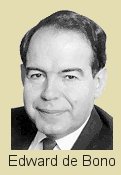 - "... We can be duly appreciative of our traditional thinking culture and also realise that it is inadequate. It may have been adequate for the period it was developed (ancient Greece and medieval Europe), but at that time there were stable societies, agreed perceptions and limited technical change. Today there are problems caused by rapidly accelerating change and the uneven nature of that change. In part these things are caused by the 'cleverness' of our traditional thinking systems and a lack of 'wisdom'."
- "The inadequacy of our traditional thinking culture may be pinpointed as follows:
We need to shift from a destructive type of thinking to a much more constructive type. We need to change from argument to genuine exploration of a subject. We need to lessen the esteem in which we hold critical thinking and to place it below constructive thinking. We need to match skills of analysis with an equal emphasis on the skills of design, We need to do as much idea-work as we do information-work. We need to realise that the analysis of data is not enough. We need to shift from an obsession with history to a concern for the future, We need to emphasise 'operacy' as much as knowledge. The skills of doing are as important as the skills of knowing. We need, for the first time, to realise that creative thinking is a serious and essential part of the thinking process. We need to move from our exclusive concern with the logic of processing to the logic of perception (from rock logic to water logic). We need to shift from cleverness to wisdom. Perception is the basis of wisdom."
The Great Wall of History
In their recent book, Civilization One, the authors Christopher Knight and Alan Butler, describe the gap between what we know of history from written records (such as those left by the Sumerians and Ancient Egyptians) and what went on before that as a barrier to our thinking, as The Great Wall of History.
 While Knight and Butler are definitely obsessed with trying to understand what really went on before there are any records surviving to guide us, they are seeking this knowledge in order to correct history. Their current reasoning would be that unless we know what really existed on the early side of the wall, humankind will be doomed to redeveloping science and technology that existed in the past - before the flood. While Knight and Butler are definitely obsessed with trying to understand what really went on before there are any records surviving to guide us, they are seeking this knowledge in order to correct history. Their current reasoning would be that unless we know what really existed on the early side of the wall, humankind will be doomed to redeveloping science and technology that existed in the past - before the flood. 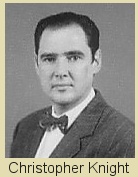 By virtue of their painstaking research and imaginative thinking Knight and Butler, now know that there was a megalithic civilization that possessed advanced knowledge and science, on the early side of the wall. By virtue of their painstaking research and imaginative thinking Knight and Butler, now know that there was a megalithic civilization that possessed advanced knowledge and science, on the early side of the wall.
These authors have encountered scepticism and blunt denial from many quarters, but their findings and their reasoning speak for themselves. It is hard for any sane person to deny the conclusions of Civilization One, but they do. This is due to a disproportionate reliance on rock logic and an inability to 'let go' and use water logic. Here is a passage from the book that entreats readers to do just that. - "The subject mater of this book requires readers to open their minds to a softer, more yielding worldview that dissolves preconceptions and temporarily allows the mind to roam freely over the subject matter, thereby allowing consideration of possibilities that might otherwise be missed. The principle that appears to underpin standard academia these days can reasonably be called 'stepping stone' logic, where deductions are often only encouraged in a strictly linear fashion. By this mode of reasoning we can only proceed by confirming each step before looking for an incremental way forward. While it sounds entirely sensible, it can blind the researcher to factors that are outside their expectations. Albert Einstein is famously said to have observed that 'Imagination is more important than knowledge'. Surely the great man has to be right: true insights come from thinking outside the box rather than simply ticking procedural boxes in a neat row.
A very famous archaeologist once said to Alan that all of his findings must be dismissed because his starting point was, in his opinion, wrong. How foolish. Even if someone does start with an error it is entirely possible that subsequent discoveries could be right if validated without reliance on the original premise. The mode of reasoning that we invite you, the reader, to adopt while reading this book is one we call the 'tepee method'. This is a multi-dimensional approach to logical deduction rather than a classical linear 'stepping stone' process. It simply requires that each piece of evidence is seen in its own right and is not forced to conform to any preconceived notion of what should be. Even where different elements of evidence appear to be mutually exclusive, we suggest that they should be allowed to coexist until the time comes for a final analysis. With the tepee method each strand of evidence is considered to be a potential supporting stick - and only if there are eventually enough of them that work together does the argument stand. We believe that this is the only approach to examining the distant past that is likely to produce a cogent picture, one that does not pick and choose which facts it prefers to accept as 'real'. As we conducted our research there were many occasions where we felt the urge to reject a finding as a coincidence because it did not fit with what we expected to see. We suspended our judgement and eventually, as a new picture emerged, we were glad that we had not tried to force our preconceptions on the evidence."
Megalithic Puzzles
Most texts and courses on human history depict a slow, step-by-step, progression from cave dwelling savages to the high technology lifestyle of the present day. In this model each generation has more knowledge and better technologies than those that preceded it. There is no place in such teaching for evidence suggesting that earlier civilizations possessed more advanced knowledge and technologies than those that followed. Yet current research is uncovering more and more examples of such evidence.
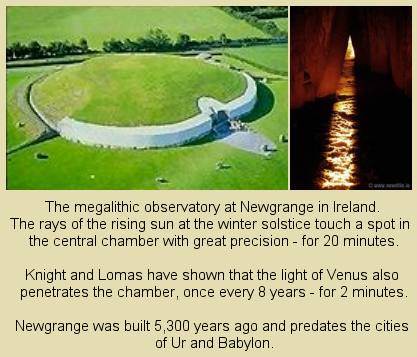
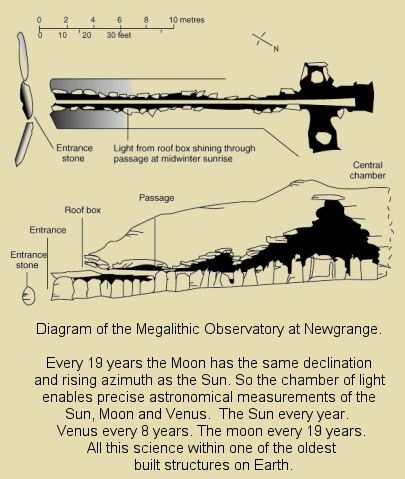
The structure at Newgrange, which was clearly an observatory and not a tomb, upsets the dominant archaeological notion of a linear, step-by-step, progression from primitive stone-age forms of society to the pinnacle of our present-day civilization. The reality of Newgrange also undermines the idea that we modern humans are the most evolved examples of our species, and that the way we live now is the way we were meant to live - the culmination of an evolutionary refinement of our physical, spiritual and technological development. The dominant theory of a step-by-step advancement of knowledge and science is not destroyed by the single example of the Newgrange astronomical observatory, but it is badly shaken.
In the north of Scotland, on the island of Orkney, there is a well preserved stone 'village' that was built around the same time as Newgrange, and where 'groove ware' pottery and carvings have been found that link the two locations. Skara Brae is a complete complex of stone quarters and linking tunnels. The construction uses double-skinned dry stone walls, with the void filled with insulating material from middens. There is a full underground drainage system to the bay of Skaill, and indications of a sewerage system that served en-suite toilets. In the centre of each room was an open hearth and six of the eight units were identically fitted out with stone furniture and water containers.

A trash-can analysis of the midden material, that insulated the complex and had built up around its external walls during 600 years of occupation, indicated that life was fairly comfortable there, despite the harsh climate of the Orkneys. The inhabitants of Skara Brae ate mainly sheep and cattle, fish, oysters, and occasionally a side of pork. Since there were no facilities for farming livestock on the island and hardly any animal skulls were found, only bones from carcasses, it seems that most of the food was imported, at considerable trouble and cost.
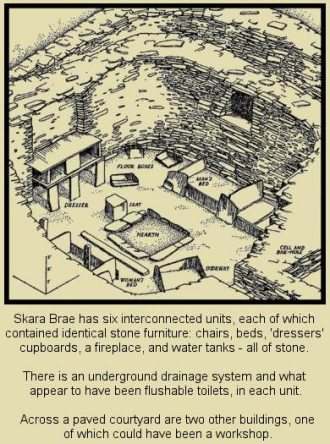
As Orkney was covered with grasslands and had few trees at that time (peat beds were not laid down until 1,000 years later) it appears certain that the inhabitants of Skara Brae also imported wood or other fuel for their heating system and kilns. Knight and Lomas have pointed out that the suggested alternatives of cattle dung or seaweed lack sufficient calorific value for the purpose of firing pottery. Since Skara Brae was in use between 3,100 BC and 2,500 BC we are not talking about farmers of peasants, the occupiers were almost certainly a royal or priestly class with sufficient power, knowledge and money to establish Skara Brae and maintain it for six centuries.
Knight and Lomas write, in Uriel's Machine, that: "Both the thoroughness of the design and the quality of the building at this site are simply breathtaking."
The authors describe the artifacts found at Skara Brae as follows. - "Besides the Groove Ware remains, some beautifully crafted stone objects have been found at Skara Brae which have no obvious purpose of any kind. ... The two most intricate are stone balls: one 6.2 cm (2.5 inches) in diameter, has been carved all over with that lozenge pattern so common on objects made at Skara Brae; the other, a slightly larger ball of 7.7 cms (3 inches) diameter, has been carved with grooves and knobs. Viewed closely, in their display case at Skara Brae, one can see that they were highly polished as if they had been handled a great deal. ..."
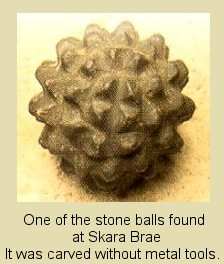
- "Around 400 similar, but less ornate, stone balls have been found in other parts of Scotland between the River Tay and the Moray Firth. Their recreation using stone tools is relatively easy, but the more elaborate balls of Skara Brae however are difficult to explain. Attempts to recreate them using Stone Age tools by engineer James Macauley failed, as it proved impossible to carve the difficult angles without using strong metal tools. For those other balls it had been suggested that the more intricate patterns had been carved during the Bronze and Iron ages. However, the stone balls of Skara Brae were found beneath the layer of wind-blown sand which was laid down when the village was abandoned in 2655 BC - long before any metal objects reached this part of the world. This poses the question, did the engineers of Skara Brae know something about the technology of working stone that we have forgotten?"
- "It brought to mind three strange facts concerning stonemasonry without metal.
Firstly, at the time that Skara Brae was suddenly abandoned, the town of Giza in Egypt was founded and the Great Pyramid was built for King Khufu, whose reign is thought to have begun in 2638 BC. it is recorded that Hemnon, the master mason in charge of the project, had his workmen use a tool that was not metal and made no sound when it shaped the giant stones of the pyramid."
[Author's Note: There is no evidence to positively date the construction of the Great Pyramid to the time of Khufu, and many researchers think it is far earlier.] "Secondly, over 1,600 years later, King Solomon had his temple built at Jerusalem, again without any metal being allowed to come in contact with the stones, despite the fact that metals had been used in the region since the fifth millennium BC." "And thirdly, today, in Masonic ritual the candidate, for the entry degree of the Entered Apprentice, the Freemason has to be 'devested' of all metal objects before he is admitted into the lodge and the ritual conducted. In the light of these facts, perhaps there was once a more advanced stone technology that has been forgotten over the millennia. ..."
Tourists and school children are told that the five thousand years old complex a Skara Brae was a normal village, implying that the people who lived there for some six hundred years were fishing, farming, or whatever else people might have done in those early times. 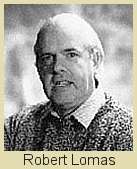 No official explanations suggest that the inhabitants of Skara Brae were operating a megalithic astronomical observatory, but Christopher Knight, Robert Lomas, and Alan Butler consider that such was the case. The people who built and occupied Skara Brae were astronomer priests, probably the same group who built the Newgrange observatory, and they were in Orkney to operate an observatory there which is now called The Ring of Brodgar. No official explanations suggest that the inhabitants of Skara Brae were operating a megalithic astronomical observatory, but Christopher Knight, Robert Lomas, and Alan Butler consider that such was the case. The people who built and occupied Skara Brae were astronomer priests, probably the same group who built the Newgrange observatory, and they were in Orkney to operate an observatory there which is now called The Ring of Brodgar.
In their book, Uriel's Machine, Knight and Lomas point to the fact that it is only an eight-kilometer drive from Skara Brae to the Ring, probably slightly less on foot and going cross-country. Here are some excerpts about the Ring of Brodgar. - "... The road runs down between the two lochs of Harray and Stennes, passing through the middle of a bowl of surrounding hills to where the Ring stands, with its four and half metre high lumps of granite planted vertically across the landscape. This immense circle has 27 standing stones still intact, but it is thought there were originally 60 of them. The stones of Brodgar are on a heather-covered plateau that is inclined towards the rising sun and, impressively, they are surrounded by a henge cut into the living bedrock.
Henges are unique to the British isles, where they are sprinkled over the landscape in their thousands. Even by today's standards, the Brodgar henge is a serious piece of civil engineering, being 110 metres (340 feet) in diameter, 10 metres (30 feet) wide and 3.4 metres (10 feet) deep. When Professor Colin Renfrew excavated sections of it he estimated that the labour needed to cut this ditch into the bedrock was at least 100,000 man hours. This seems an enormous investment of time for what was a small population of people with an expected average lifespan of little more than 25 years. Renfrew's calculation is a minimum estimate, but assuming that 40 men could work 50 hours every week through all of the seasons, it would still take them a year to cut the henge alone. Those men would have needed a great deal of support infrastructure, to provide raw food, import fuel, cook the food, make clothes and prepare a continual supply of new cutting tools. In short, this work must have been very important to a community, consuming almost its entire productive output for a long period of time. There are two entrance banks across the ditch into the ring, in the north-west and the south-east, which, at first sight, seem to marry with the general direction of the summer-setting sun and the winter-rising sun. On the farthest point of the road, to the north-east, is a later flat-topped mound which provides a panoramic viewpoint of the whole ring. Engineer and archaeo-astronomer Professor Alexander Thom believed this mound was built to provide accurate foresight of the rising moon, and he estimated from astronomical observations that the platform was probably built about 1,000 years later than the henge. 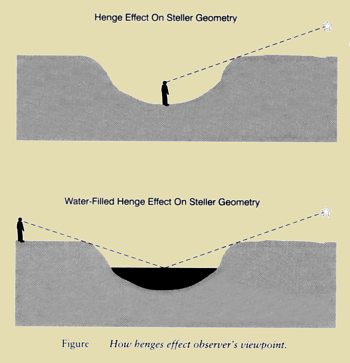
In the 1960s, Thom, a retired professor of engineering from Oxford University, established that the Ring of Brodgar and most other megalithic sites in western Europe were built using a standard unit of measure which he dubbed the 'Megalithic Yard". He also suggested that the reason for digging the henge at this spot was because it provides four major foresights to observe movements of the moon - known as major and minor standstills - which are important to the prediction of its cycles. In his view, the purpose of the outer bank to the henge would have been to provide a controlled artificial horizon for viewing these major and minor standstills in the moon's orbit. This means that the henge was part of a scientific instrument on the scale of, and as purposeful as, a radiotelescope of today. For its ancient users it provided an horizon that was perfectly flat in all directions and allowed the heavens to be viewed as an exact hemisphere." - "At the time of Thom's work, his talk of an international standard of measurement and the construction of astronomical observatories over 5,000 years ago was thought to be laughable. According to the ruling clan of archaeologists the population of the British Isles had been savages, not scientists - so, de facto, Thom must be wrong. He has since been proven to be entirely correct, thanks to independent statistical analysis."
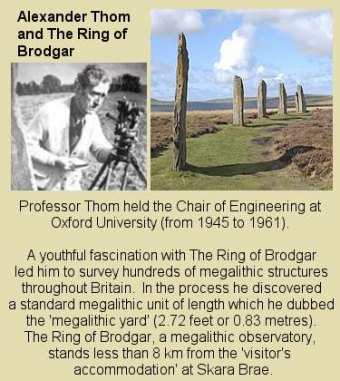
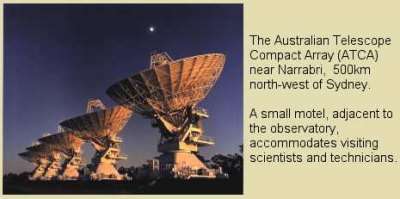
How is it that we are still researching and debating the existence of very advanced astronomical knowledge and measurement standards in prehistoric times? Is it because our ancient ancestors failed to write down or pass on their knowledge to later generation in stories and songs? I personally doubt it. I suspect that we have been left with megalithic puzzles about the events on the hidden side of the Great Wall of History because of the actions of elites who rigorously suppressed the knowledge for their own ends. The first Dark Age, in Europe, was only brought to an end by the Renaissance, and the Reformation that sprang from it. As recently as 500 years ago the Roman Church had the people of Europe believing that the sun and the heavens revolved around the Earth, which was the centre of the universe, and ruled by a pontiff whose judgement was infallible. All the ancient knowledge and wisdom had been destroyed or hidden away in vaults, and generation after generation of educated children in Europe had been taught to think what the ruling class wanted them to think.
There was a second Dark Age, that began in the late 19th century, and served to delay the application of major scientific discoveries to anything other than military uses. It was not the Roman Church that was responsible for suppressing that more recent knowledge, it was central governments and federations of formerly free states. But more of that in another freesite. For now, let's continue to discover what really went on 5,000 years ago on the hidden side of the Great Wall of History. We can, indeed, be astounded by and very appreciative of the achievements of those early people.
Six Hundred Sites, A Single Measurement Standard
In their book, Uriel's Machine, Christopher Knight and Robert Lomas describe recent dating of the pre-historic stone monuments of western Europe. Revised carbon 14 dating techniques developed by Professor Hans Suess of the University of California have established that these structures predate the earliest Sumerian and Egyptian cities. Knight and Lomas quote Lord Colin Renfrew, who had been Disney Professor of Archaeology at Cambridge University, commenting on this finding. He stated that "There are no stone-built monuments anywhere approaching them in antiquity. Perhaps even more remarkable, some of these underground burial chambers, with their roofs of stone, are preserved entire, so that we can enter them and stand inside a stone chamber which looks today just as it did more than 5,000 years ago. Now the paradox is with us again: that such impressive monuments were created many centuries before the Pyramids by barbarians who lacked even the use of metal." The puzzle of megalithic architecture was deepened by the now widely confirmed statistical analysis of some six hundred sites in Britain and western Europe, by Professor Alexander Thom. He concluded that a standard measure of length was in use across this whole area during megalithic times. Thom determined that the length of a megalithic yard was precisely 2 foot 8.64 inches (32.64 inches). Knight and Lomas note that Professor Thom considered that a long-forgotten physical standard of length must have been in operation. In respect of the stone constructions that still exist across an area of 150,000 square miles they write that:
- Thom felt that they were far too consistent to have been delineated by the use of measuring rods, created, copied and distributed across this huge area, as the very act of duplication would have introduced a greater level of error than is evident in the structures.
It was left to Knight, Lomas, and Alan Butler, to unravel the puzzle of how people 5,000 years ago maintained such a consistent standard of length in their constructions.
Three Hundred and Sixty Six Beats
Knight and Lomas began their search for the solution to the puzzle of the megalithic yard by looking for a scientific basis to the standard. They write that: - "The alternative to the 'ruler' theory is that there must have been a physical reality behind the unit which would enable it to be recreated by any individual who understood the underlying science. This is how the metre is currently defined - in terms of a number of wavelengths of a particular frequency of light."
Alan Butler had done research into the Minoans use of a 366o circle 4,000 years ago, and there seemed to be links to the mathematics of the megalithic people of Western Europe. Butler helped Knight and Lomas to find an astonishing solution to the puzzle of the megalithic yard, and probably the gaz unit once used in India. The latter standard derives from the Bronze Age Indus civilization and was standardised at 33 inches by the British government during the nineteenth century. The method of establishing the standard for the megalithic yard is described thus by Knight and Lomas. - "What the ancient engineers had done was to mark out a circle of substantial diameter using a cord and centre pin, and then divide the circumference into exactly 366 equal cords by trial and error. They had then erected two posts to mark out one 366th part of a circle, and swung an adjustable pendulum until it produced exactly 366 beats during the transit of a convenient bright star between the two posts. The length of the pendulum is now exactly one half of a megalithic yard, a basic unit of construction discovered by Professor Thom when he surveyed hundreds of ancient ruins in Scotland, England, Wales and western France."
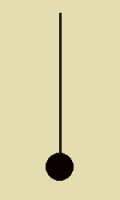
The authors of Uriel's Machine summarise the scientific basis of the megalithic yard as follows.
- "The megalithic unit of measurement used at 'The Hill of Many Staines' and other sites up to 1,300 kilometres away, is a truly staggering concept of measurement. Professor Thom's megalithic yard was based on pure geometrics, derived from three absolutely fundamental values:
- The orbit of the Earth around the sun.
- The rotation of the Earth on its own axis.
- The mass of the Earth.
The Earth's orbit gave the 366 split of the horizon, the rotation of the Earth gave the timespan, and the mass of the planet (gravity) dictated the length of the line to give 366 beats." All this seems to have been going on in Europe thousands of years before Galileo Galilei (1564-1642) was censured and imprisoned for daring to assert that the Earth revolved around the sun.
Uriel's Machine
Knight and Lomas did more than theorise about the basis of the megalithic yard, they reconstructed a megalithic observatory on the site of an ancient stone circle in West Yorkshire that is thought to have been originally built by the people of a place called Meg's Dyke. Using the circle and wooden staves to mark positions of the sun, the authors were able to verify the astronomical basis of the megalithic circles which exist at sites throughout Western Europe. An ancient Jewish text known as The Book of Enoch contains solar, lunar and other astronomical information that can be determined using such sighting circles. The knowledge of astronomy required to construct and use the circles is said to have been imparted to Enoch by an angel named Uriel, hence the circular observatories are termed Uriel machines by Knight and Lomas. Those who prefer to discount the reliability of the ancient text of Enoch, and consider instead that the circles were merely designed to tell farmers when to plant crops, must reckon with the evidence provided by Knight and Lomas. These authors point out that: - The knowledge contained in the Book of Enoch was known to Freemasons long before the text was rediscovered by James Bruce during the 18th century, and does not derive solely from scholarly studies of that document
- Both Professor Thom's analyses and practical use of the reconstructed circle near Meg's Dyke show that a Uriel Machine is capable of determining, within an accuracy of one arc minute:
- the inclination of the ecliptic
- the inclination of the lunar orbit
- the mean amplitude of the lunar perturbation
- the mean lunar parallax
- Alan Butler also determined that a Uriel Machine could have been used to determine the circumference of the Earth to an accuracy that was within 20 metres of that obtained today, using the latest satellite technology
Those ancient people were constructing and using an astronomical device that has been shown to be far more versatile and precise than any means of determining crop cycles would ever need to be. We must assume that they knew fully what they had built and what it could be used for.By studying a 3,500 year artifact known as the Phaistos Disc, Alan Butler had established that the Minoans also had similar knowledge and that 1,000 Minoan feet were exactly equal to 366 megalithic yards.
Civilization One
Feeling that the identical correspondence between Minoan feet and megalithic yards could not be a coincidence Knight and Butler dug further, and uncovered irrefutable evidence of the existence of a highly advanced culture that predated the earliest known civilizations, such as those of Sumer and Egypt. They termed it Civilization One, and their book of the same name makes it clear just how much those ancient people knew about the heavens.
They might not have used metals, and they do not seem to have left any written records capable of surviving for tens of thousands of years, but our ancestors from so far in the past devised an integrated system of weights and measures that was more advanced than our 'modern' standards, and which is still reflected in both Imperial and Metric measures. We have kept much of the original system, which was as near perfect as it could be, but we have forgotten the ancestors who designed it. We now teach our children that all the people on the hidden side of the Great Wall of History were primitive savages, while at the same time we teach them about weights and measures that are directly based on the system devised by the scientists of Civilization One.
This freesite only repeats a few of the more startling findings and conclusions made by Knight and Butler, you must read Civilization One in order to comprehend the full picture and understand how much ground it cuts from beneath the feet of the archaeological establishment. The inside cover of the book makes this clear. It says, in part:
The details of the Civilization One book and website are:
Knight Christopher, and Butler, Alan Civilization One, The World Is Not As You Thought It Was, (Watkins Publishing, London, 2004)
www.civilizationone.com
Details of other books, such as Uriel's Machine, referred to on this freesite can be found via the 'Sources 2R' link on the sidebar below.
Exact Measures
Until the work of Alexander Thom the archaeological 'truth' was that all early measures were based on the averaging of the length of body parts, such as feet, arms, hands, and fingers. But Thom's work, although he could not explain it, showed that there had been an exact system of measurement employed across the British Isles and western France. Here are some excerpts from Civilization One. - "In 1955, after analysing the data from the surveying of 46 circular stone rings, Thom concluded that they had been laid out as multiples of a standard unit of measurement that had been used throughout Britain. Alexander Thom and his son Archie, who had begun to assist him in his work, eventually arrived at a definitive length for the Megalithic Yard of 2.722 feet +/- 0.002 feet (82.96656cm +/- 0.061cm).
Thom found small variations in the length of his Megalithic Yard but the distribution of error was utterly consistent, centring on a tiny range - not a fuzzy zone as would be expected from an ancient measure. The distribution graph of variations kept powerfully centring on a single point." - "At the time Thom's data could not be explained by any mechanism known to be available to the people of the late Stone Age other than to assume that all [measuring] rods were made at the same place and delivered by hand to each and every community across Scotland and England. Eventually he would find the unit in use from the Hebrides to western France, which makes the central ruler factory theory look most unlikely. He also found it impossible to imagine why these early communities wanted to work to an exact standard unit."
- "Although he could not explain it, Thom stood by his data. While he was puzzled, many people within the archaeological community were not. For most archaeologists it was a simple case of an engineer playing with something he did not understand and getting his facts wrong. ... However, when the Royal Society under the auspices of Professor Kendal was asked to check his work in order to find the error, it responded by stating that there was one chance in a hundred that Thom's Megalithic Yard had not been employed on the sites surveyed."
- "The difference in approach between Thom and the general archaeological community is fundamental. In simple terms, archaeologists are experts in the recovery and cataloguing of manufactured artefacts that allows them to understand rates of development and influences between groups. They dig up the remains of human settlements and piece together some idea of the community involved from written records and lost or discarded items. This process works well in Egypt where there is an almost boundless supply of artefacts and documents to give us an insight into the lives of its people. However, the procedure is less than satisfactory when considering the structures of Megalithic Europe because there are few artefacts to be retrieved and no written records at all."
- "Dr Aubrey Burl, the highly respected archaeologist whom Thom quoted extensively, confirmed to us that he did not believe in the reality of the Megalithic Yard, stating that he had excavated many Megalithic sites but never found the measurement. This statement reveals a collision of techniques since it is difficult to itemise one specific Megalithic Yard at any ancient site. This is because the unit in the sense that Thom often found it only reveals itself from the careful gathering of huge amounts of data extracted from every site.
Although individual standing stones have been shown by Thom to have moved very little over the centuries, an entire site must be meticulously catalogued before the Megalithic Yard really makes its presence felt."
The Megalithic Yard is a Geodetic Unit
Scientists have defined the modern unit of length, the metre, in various ways at various times. - Initially a metre was 10-7 times the distance between the North Pole and the Equator along a meridian passing through Paris.
- Between 1889 and 1960 it was the distance between two inscribed lines on a platinum-iridium bar kept at the International Bureau 0f Weights and Measures, near Paris.
- Between 1960 and 1984 the metre was defined as 1650763.73 wavelengths of the orange-red line of krypton-86 propagating in a vacuum.
- Presently it is the length of the path travelled by light in a vacuum in the time interval of 1/299,792,458 of a second.
A geodetic unit is one that is derived from the geometry of the Earth, so some of the above definitions of the metere are geodetic and others are not. Alan Butler's earlier research on the Minoan unit of measure led him to suspect that the Megalithic Yard was geodetic and similarly based on the 366 rotations of the Earth in a year.
We are used to thinking of a year as having 365 days, but these are solar [sun] days rather than sidereal [star] days. Knight and Butler explain the difference thus: - "... A solar day is that measured from the zenith (the highest point) of the Sun on two consecutive days. The average time of the Sun's daily passage across the year is called a 'mean solar day' - it is this type of day that we use for our timekeeping today. A sidereal day is the time it takes for one revolution of the planet, measured by observing a star returning to the same point in the heavens on two consecutive nights. This is a real revolution because it is unaffected by the secondary motion of the Earth's orbit around the Sun. This sidereal day, or rotation period, is 236 seconds shorter than a mean solar day, and over the year these lost seconds add up to exactly one extra day, giving a year of just over 366 sidereal days in terms of the Earth's rotation about its axis."
- "In short, anyone who gauged the turning of the Earth by watching the stars would know full well that the planet turns a little over 366 times in a year, so it follows that this number would have great significance for such star watchers. If they considered each complete turn of the Earth to be one degree of the great circle of heaven, within which the Sun, Moon and planets move, then they would also logically accept that there are 366 degrees in a circle."
- "There really are 366 degrees in the most important circle of them all - the Earth's yearly orbit of the Sun. Anything else is an arbitrary convention.
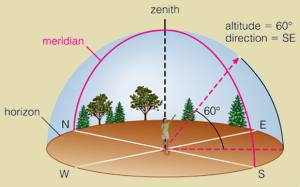 It seemed to us that this was so logical that the 360-degree circle may have been a later adjustment to make arithmetic easier, as it is divisible by far more numbers than the 'real' number of degrees in a year. In other words, the circle of geometry has become somehow detached from the circle of heaven. How right we were, and the truth of the situation would become all too clear to us as our research progressed." It seemed to us that this was so logical that the 360-degree circle may have been a later adjustment to make arithmetic easier, as it is divisible by far more numbers than the 'real' number of degrees in a year. In other words, the circle of geometry has become somehow detached from the circle of heaven. How right we were, and the truth of the situation would become all too clear to us as our research progressed."
When they did some calculations using megalithic yards the the intrepid researchers received a real surprise. Taking the most commonly quoted value of the polar circumference of the Earth - 40,008 kilometres - they converted this to megalithic units.
This gave the polar circumference of Earth as 48,221,838 Megalithic Yards (MY)
Thus a 366 degree polar circumference would contain 131,754 MY per degree. Since Alan Butler had found that the Minoans had, in megalithic times, divided each degree of arc into 60 minutes and each minute into 6 seconds, they did the following calculations.
the full circle of the Earth = 48,221,838 MY
one degree (a 366th part) = 131,754 MY
one minute (a 60th part) = 2,196 MY
one second (a 6th part) = 366 MY
Use of a 366 degree geometry meant that each second of arc of the polar circumference of the Earth is precisely 366 Megalithic Yards in length. This could not be coincidence, real science and understanding was at work in megalithic times. As Knight and Butler put it:
- "We were now feeling increasingly confident that the Megalithic Yard was a real unit of length and not a statistical blip as suggested by some archaeologists - who unfortunately have never taken the time to throughly investigate the issue."
Exactly 366 Beats For Venus
Devising a repeatable unit of measurement using only the materials available to people in prehistoric times came down to swinging a pendulum, a simple pebble on the end of a string or cord. Here are some excerpts from Civilization One.
- "The time it takes to swing a pendulum is governed by just two factors: the mass of the Earth and the length of the pendulum from the fulcrum (the point at which it is held and pivots) to the centre of gravity of the weight. Nothing else is of significant importance. The amount of effort that the person holding the pendulum puts into the swing has no bearing on the time per swing because a more powerful motion will produce a wider arc and a higher speed of travel, whereas a low power swing will cause the weight to travel less distance at a reduced speed. Equally, the heaviness of the weight of the object on the end of the line is immaterial - a heavier or lighter weight will simply change the speed/distance ratio without having any effect on the time of the swing.
The mass of the Earth is a constant factor, although there are tiny variations of the acceleration due to gravity at different latitudes and altitudes because the Earth bulges slightly at the equator, causing a minute change in the angle to the Earth's core. However, in an area the size of the British Isles anyone swinging a pendulum for a known number of swings in a fixed period will have almost exactly the same pendulum length." - "When we first looked at this problem with Robert Lomas we had outlined a technique of measuring the rotation of the Earth by standing in the centre of a large circle and watching a star pass between two pillars that were spaced to be 366th of the circle of the horizon. We found that we could produce a pendulum length that was very close to a half Megalithic Yard by swinging the pendulum 366 times during the passage of the star. The swings required were actually closer to 365½ but we reasoned that the user would have counted the last swing in full.
Long after our joint investigation with Robert Lomas in this exercise was over, we returned to the issue of the small discrepancy between Thom's Megalithic Yard and our pendulum-based result. The process we had identified seemed too close to be plain wrong and yet what amounted to half a pendulum swing niggled away at the pair of us. The more we thought about it, the more we felt we had missed something very significant. We decided to investigate every possible option including the use of the Sun, Moon and the planets as indicators of the passage of time. Ultimately we found our candidate and, once we did, we kicked ourselves for not having recognised it all along. It was the planet Venus that our ancient ancestors had used to calibrate their pendulum and therefore keep the size of the Megalithic Yard absolutely accurate." - "The technique required was very straightforward. A circle had to be constructed from a centre pole using a rope before dividing the perimeter into 366 sections. This could be done by trial and error or by using a trick of geometry: making the diameter 233 units across (any unit will do) and then measuring off 2 units on the circumference. The pendulum bearer would then stand in the middle of the circle while a colleague erected a square frame that had an internal dimension equal to one Megalithic degree. The square was adjusted until the pendulum bearer confirmed that its top and bottom were aligned with the passage of Venus.
The bearer then started swinging the pendulum when Venus appeared inside the square and stopped when it disappeared again. there was no likelihood of error since it is clear that these sky watchers knew to check Venus on a regular basis. Because Venus sometimes moves faster within the zodiac than at other times, the very longest half Megalithic Yard pendulum achievable within the Venus cycle was the one they were looking for. If the bearer had been able to count exactly 366 swings, they knew they had confirmed their pendulum as being half a Megalithic Yard. If the count was short, they repeated the process after reducing the length and, conversely, the length would be increased if too many swings had occurred." - "Working with Robert Lomas, Chris has published findings that demonstrate the huge importance of Venus to the builders of Megalithic sites in the British Isles. The gigantic and very beautiful 5,000-year-old observatory at Newgrange was painstakingly designed to let the light of Venus into the central chamber for only minutes once every eight years on the winter solstice. This and other sites would have enabled the Neolithic astronomers to maintain a completely accurate calendar. ..."
- "From Alan's point of view, the realisation that Venus could act as the necessary pendulum-setter came as direct proof of the validity of his own earlier discoveries regarding the Phaistos Disc.
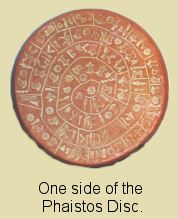 The Phaistos Disc is a 6 centimetre baked clay disc, found in the ruins of the Minoan Palace of Phaistos in Crete. It dates back to the Minoan civilization (circa 2000 BC) ... For the moment it is sufficient to say that this amazing little disc is a multifaceted calculating machine, based on the Megalithic 366-day year. One of the jobs it performs is to indicate to those using this year when to compensate for the difference between the ritual year of 366 days and the true solar year of 365.35 days. However, the disc does more than this because it also provides the mathematical framework for establishing the position of Venus in the zodiac on any day - ever. It does this in a very simple way, [explained in Appendix 5 of Civilization One] but the fact remains that Venus tracking is an essential part of the abilities of this calculator." The Phaistos Disc is a 6 centimetre baked clay disc, found in the ruins of the Minoan Palace of Phaistos in Crete. It dates back to the Minoan civilization (circa 2000 BC) ... For the moment it is sufficient to say that this amazing little disc is a multifaceted calculating machine, based on the Megalithic 366-day year. One of the jobs it performs is to indicate to those using this year when to compensate for the difference between the ritual year of 366 days and the true solar year of 365.35 days. However, the disc does more than this because it also provides the mathematical framework for establishing the position of Venus in the zodiac on any day - ever. It does this in a very simple way, [explained in Appendix 5 of Civilization One] but the fact remains that Venus tracking is an essential part of the abilities of this calculator." - "When the Venus experiment was undertaken in Orkney, Scotland, where some of the most magnificent of the Megalithic monuments are to be found, the size of the resulting pendulum was very significant. The pendulum would prove to be a half Megalithic Yard, the full length of which would deviate from Alexander Thom's findings by a staggering 1 part in 2,700. Allowing for the human factor (that someone has to hold the pendulum and decide when to start and stop it) the Venus-based half Megalithic Yard pendulum was perfect. Our result was within the very fine margin of error identified by Professor Thom."
- "There is no doubt that the Megalithic Yard is a superb integer of the polar circumference of the Earth - right down to a second of arc that is an incredible 366 Megalithic Yards in length. Once this unit had been defined by obviously gifted astronomers, these early scientists appear to have created a foolproof method that every master mason could use to generate an accurate Megalithic Yardstick.
This whole process is brilliantly simple, memorable and unerringly accurate. Of course there will have been errors of judgement when transferring the length from the pendulum to a measuring stick but that is the kind of distribution error that Alexander Thom found. Because there is a physical reality behind the process, all errors deviated from a central point of 82.96656 centimetres. Pure Neolithic genius ! "
Measures Of Civilization
Although theirs was the only evidence, so far, that an advanced culture had existed in Stone Age Britain, Knight and Butler reasoned that once the undoubtedly clever people who created sites such as Newgrange and the Ring of Brodgar had defined their Megalithic Yard they would have gone further. Having found units of time and linear measure, the pair began to look for units of weight and capacity. They reasoned that a developed civilization would have needed such measures for trade and many other purposes. What they found is startling, amazing, wonderful. The very measures of length, liquid volume and dry weight, that we have always believed to have evolved from arbitrary standards, and within civilized times, actually come from beyond the Great Wall of History.
For brevity, I will skip the incredible detective work that led Chris knight and Alan Butler to this secret, and simply summarise some of their main findings. But I urge you to buy, read and cherish their book, Civilization One. For it will become a classic. If you have children make sure that they learn the truth about the origin of the weights and measures we use today, and come to know that the modern theory of a step by step advancement of civilization, from primitive Stone Age people to the mega-violent, high-tech societies we live in today - is an absolute fallacy. We simply are not the most advanced and best examples of humanity ever to exist on this planet. And the way we live now is by no means the way we were meant to live.
The essence of what Knight and Butler discovered about the connections between ancient measures and our present-day standards is captured in the following excerpts from their book. - "At some point in the distant past when trade was developing, someone had created a system of weights and measures using the Megalithic Yard and Megalithic Inches as a starting point. Taking a length of one tenth of a Megalithic Yard as the internal dimension they carefully cut five pieces of slate and sealed the joints with fine clay. This innovator then filled the cube with water until the meniscus was bowing at the rim. Next they poured off the water into a clay beaker and marked the water line on the inside to create a standard unit of liquid that just happens to be the same as an imperial pint. A further procedure was to fill the same cube with grain, gently patting the top to ensure that it was as level as possible within the cube. Our imaginary scientist then poured the grain onto a simple balance and chipped shavings from a stone on the opposite side until the scales were in equilibrium. This stone was thereafter a standard unit of weight that, once again, just happens to be the same as an imperial unit - the modern pound. This hypothetical early trader thus could have created accurate and repeatable units of liquid measure and dry weight simply by watching the motion of Venus crossing the heavens. What a magical thought ! "
- "The pound and the pint could be recreated anywhere by anyone with the necessary knowledge to watch Venus travel across one 366th part of the sky and swing their pendulum the required number of times. By any reasonable definition these were divine units taken straight from heaven. There is no magic in this, just science, and what is more, science as pure and perfect as it would ever need to be to create a springboard for civilization."
Moving from the Megalithic Age to the later Sumerian civilization, in the land that is now Iraq, Knight and Butler discovered, by reverse engineering the recorded length of the Sumerian half-kush (from a graduated rule engraved on an unearthed statue of the Sumerian King Gudea) of 24.97 centimetres, that a pendulum of this length has a swing of one second. The Sumerians not only invented the time system we use today, and the second, they appear to have applied the Venus method to derive their system of measures, which turn out to be identical with the modern metric system.
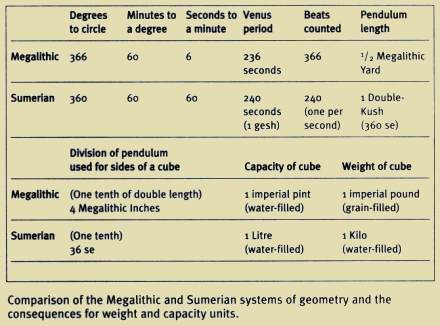
The above table is taken directly from Civilization One. Writing of the 'coincidence' by which the French devised their 'new' Metric System in the late 18th century, they say: - "Prior to the early 14th century, France was a series of different states which had not been united since Roman times. These were only welded together again as a result of conquests and dynastic unions resulting in virtual chaos, with a wealth of different length, weight and volume unit names and sizes existing simultaneously across the new country. ..... The chaos continued until some new data on the circumference of the Earth was published in 1670 by Jean Picard, a priest and an astronomer living in La Flèche. Picard accurately assessed the polar circumference of the Earth using the distance from Sourdon near Amiens, to Malvoisine south of Paris, as his test area. This gave another priest an inspired thought.
Father Gabriel Mouton of St Paul's Church in Lyon put forward the suggestion that France should design a completely original set of decimalised weights and measures based upon an agreed fraction of one minute of arc of the newly-measured polar circumference of the planet. The idea immediately caught the imagination of leading thinkers, but Picard did not agree with Mouton's suggestion for the means of devising a linear measure. Instead, together with astronomer Ole Rõmer (a distinguished scientist from Copenhagen who spent long periods in France and Germany), Picard proposed that the new unit of linear length upon which everything else could be based should be precisely the length of a pendulum with a beat of one second of time." - "The concept of a 'seconds pendulum' had been first identified by Galileo earlier in the same century when he became the first recorded European to actively experiment with pendulums, though it was left to the Englishman Isaac Newton (1643-1727) to later establish the correct dimensions for the seconds pendulum. The device had a particular fascination for Newton, who experimented extensively in all matters pertaining to gravity. Newton had calculated that a freely-swing pendulum, at a location of 45 degrees latitude, with a beat of exactly 1 second, would measure 39.14912 inches in length ... (While this is all of great historical interest we demonstrated in the last chapter that the Sumerians had achieved all these objectives some 3,500 years earlier.)"
- "Despite the debates about the best way forward nothing further seems to have happened regarding the new French system until the 14th July 1789 when the Bastille was stormed, igniting a revolution that was to change the country forever. ... with the beginning of a completely new regime, the populace could be persuaded to change everything it had known for generations in terms of weights and measures."
- " ... the Assembly set up a commission to look into a new metric system. It was composed of five brilliant scientists and mathematicians. These men were Laplace, Lgrange, Monge, Borda and Condorcet. The report produced by this commission was presented to the French Academy on 19th March 1791.
It was at this time that the concept of the seconds pendulum was more or less abandoned as the preferred unit for the new linear measurement because it was reluctantly decided that no timepiece existed that could accurately measure one second of time. The commission was left with no option but to return to Father Mouton's original suggestion that the new unit should be derived from an extremely accurate assessment of the distance between the North Pole and equator and to make the new linear unit a subdivision of this distance. Despite this decision, the seconds pendulum was not forgotten. ... the seconds pendulum was retained as a safety backup should the new unit of length ever be lost. This indicates that the French team had chosen a subdivision of the polar circumference that was as close to the seconds pendulum as they could achieve using a very round number. They settled on one ten-millionth part of the meridian quadrant - which meant that the new unit was one forty-millionth part of the polar circumference of the Earth. This unit was eventually to be named the 'metre'. It is clear from the wording of the report presented by the commission that it was aware of the very slight difference in length between the established seconds pendulum and the proposed linear unit." - "It appears than none of these French scientists questioned what a second of time actually was or where it had come from, except that it represented 1/86,400 part of a mean solar day. They knew it had originated from ancient Mesopotamia but the Sumerian culture had not been identified at the time. It was much later that archaeological digs in the sands of Mesopotamia began to turn up scores of cuneiform tablets and slowly some people began to notice the amazing similarities between the Sumerian measurement system and the metric system. Professor Stecchini has shown how there was distinct embarrassment in academic circles at the convergence of a new and scientifically-based system with that of the most ancient documented culture on the planet."
- "The French team that did not trust their 18th-century timepieces would no doubt be amazed to learn that one day their metre would be defined as the distance travelled by light in a vacuum in a time interval of 1/299,792,458 second. We now have the science to measure such tiny events but it remains a fact that the true seconds pendulum lies behind this definition. Bearing in mind that a pendulum length changes somewhat according to the latitude at which it is checked, the astronomer-priests of old made an extremely good job not only of defining the second of time, but also of showing what it meant in linear terms. The double-kush pendulum ticks away seconds with an error of only one five-thousandth of a second, an error that to anyone except the most fastidious Grand Prix racing driver means nothing ! "
Measures Of Science
It is one thing to show that someone in prehistoric times developed wonderfully elegant measures of length, weight and capacity, which then facilitated the growth of trade and a higher level of civilization. It's amazing, but it also seems like a practical step in the development of human societies - from hunter-gatherers to town-based traders. What is really staggering is the full and complete grasp of science that our ancient ancestors possessed. This was not science for the sake of commerce, but science for science's sake - pure science. We are talking of accurate knowledge of the weight of the Earth, the speed of light, the ratio of phi (or Golden Mean), geometric relationships between the Earth and the Moon: that kind of stuff. Way, way, back on the far side of the Great Wall of History.
I'm not going to sketch out all the scientific knowledge that Knight and Butler have been able to uncover by following threads of inquiry that all trace back through time to the Megalithic Yard and the geometry associated with it. Rather, I encourage you to study the remarkable findings documented in Civilization One for yourself.
What should be noted here, because it is very important, is the global extent of the ancient knowledge. It was not confined to Britain, Europe, Egypt, or Mesopotamia, but incorporated into the measures and even the music of cultures such as China, India, and Japan. This strongly suggests that the ancient ancestors who possessed such deep scientific knowledge were able, somehow, to spread it around the old world.
The Afterglow Of The Megalithic Yard
The following excerpts from Knight and Butler's book indicate how, when they went looking for connections to the Megalithic Yard and ancient knowledge they found them in quite unlikely forms and places.
These and other findings have convinced Chris Knight and Alan Butler that a very advanced civilization existed in ancient times and that the notion that we present-day humans are the first of our kind to achieve a deep understanding of science and the cosmos is totally wrong. In conclusion they say: - "We have found that the further back in time we go, the greater the interconnections between units - and the deep science behind the very oldest measures makes modern systems seem arbitrary and trivial. It appears that before history was written there was an apparently single approach to measurement units that was based on the physical realities of the Sun, the Moon and the earth."
- "For all the world it feels as though both Megalithic Man and the Sumerians shared the same teacher. The sudden development of brilliant cultures after more than 5,000 generations of humanity and the absence of any audit trail strongly suggests the intervention of a third party that is no longer known."
- "Unfortunately there are no documentary records of Neolithic traditions - but we know that the Sumerians and the Egyptians specifically stated that a group of people with, what appeared to them to be, god-like powers arrived form somewhere unknown to instruct them in the sciences and teach them skills in manufacturing. These 'Watchers' were thought of as gods, but it is said that they looked like normal people and they lived and died just like everyone else. While it is fashionable today to dismiss only myth and legend as little more than fairy stories, we believe that this explanation holds more water than any other."
- "Could it be that there was once a single, highly-advanced group that virtually kick-started the world's first civilization? If so, it appears that it failed in the case of the Megalithic culture because it seems to have died out. And yet in a way it never will, as long as any person on the planet orders a pound of apples or downs a pint of beer."
Author's Note:Some of the following sections are repeated or adapted from the content of the 2nd Renaissance freesite. You can find that site, which has other content that is not included here, by clicking on the '2nd Ren Down' link on the sidebar below.The terms 'Takers' and 'Leavers' come from the thinking of the prize-winning author, Daniel Quinn. They are fully explained in the 2nd Renaissance content. Briefly, Takers exploit the land and its resources and assume for themselves the power of life and death over all other creatures. Leavers, on the other hand preserve a balance in the way they draw sustenance from the land and respect the role of a higher power in deciding issues of life and death.
Knowledge Lost - Knowledge Regained
Crichton E. M. Miller is another researcher and revisionist of the historical record. In his book, The Golden Thread of Time, Miller writes: "The creation of the present society began two thousand years ago with the persecution of millions and the deliberate destruction of knowledge that was in conflict with new beliefs. 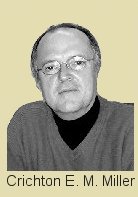 For two thousand years, free thinking people have been horrendously tortured, betrayed and destroyed by those who thought it in their interests to suppress anything that would be considered a threat to their control over the masses of mankind." For two thousand years, free thinking people have been horrendously tortured, betrayed and destroyed by those who thought it in their interests to suppress anything that would be considered a threat to their control over the masses of mankind." Miller observes that it has been all too easy for truth and knowledge to be suppressed or otherwise forgotten. He writes, "The majority of us do not question our teachers; we believe what we are taught is the truth. It never even enters our mind that these people in authority, with whom we entrust so much, may not be teaching us the truth or perhaps they are victims too and do not know themselves." Fortunately Crichton Miller is made of different stuff and his open and inquisitive search for truth led to a startling rediscovery of ancient knowledge. He found that a widely known object held secrets that nobody in modern times seems to have discerned. As he puts it, "Our powers of discrimination are supposed to be for survival and yet we are unable to discriminate between a religious icon and a mathematical instrument when it is constantly in front of us."
The Cross of Ancient Navigators
As a skilled navigator and qualified Royal Yachting Association Yacht Master, Crichton Miller disputed the common assertion that everyone in ancient times, including the Phoenicians and Egyptians, believed that the Earth is flat. He points out that in a vessel at sea, "You immediately notice that things disappear over the horizon as you leave them behind, and rise above the horizon as you approach." Some academics might argue that the ancients did not have ships capable of navigating out of sight of land, however Miller points out that seagoing ships are clearly illustrated in friezes on the mortuary temple of Queen Hatshepsut (C 1503-1482 BC) at Thebes. He writes that, "The sail plan was very efficient and capable of upwind work... They are capable of travelling the world, providing that the ship's master knows where he is." 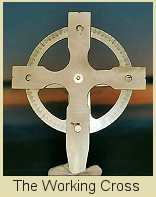
Since the question of knowing where one is becomes crucial for any voyage beyond sight of land, Miller sought to devise a means of navigation based on solar and astronomical observations. His resulting discovery was remarkable, a working version of the Celtic cross that not only provides full navigational capabilities at sea but also enables the accurate determination of angles and distances in surveying and construction. 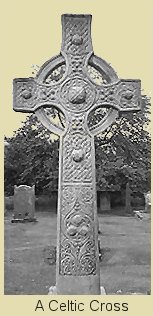 Prior to Miller's development of a fully working cross the concept was unknown and the Celtic cross was thought to be purely a religious symbol. Crichton Miller writes that, "This magical instrument that I have discovered, hoary with age, is not solely used for navigational purposes . It encompasses a knowledge of the cosmos, the use and understanding of mathematics, geometry, surveying, astronomy and astrology and it was used long before the ancient Egyptians built their pyramids. The secrets of this device were the foundations of ancient civilizations... It was the staff of magicians. I have searched high and low, in libraries, museums and the Internet, even with experts and engineers but to no avail, no one in the modern world previously knew of its existence." Prior to Miller's development of a fully working cross the concept was unknown and the Celtic cross was thought to be purely a religious symbol. Crichton Miller writes that, "This magical instrument that I have discovered, hoary with age, is not solely used for navigational purposes . It encompasses a knowledge of the cosmos, the use and understanding of mathematics, geometry, surveying, astronomy and astrology and it was used long before the ancient Egyptians built their pyramids. The secrets of this device were the foundations of ancient civilizations... It was the staff of magicians. I have searched high and low, in libraries, museums and the Internet, even with experts and engineers but to no avail, no one in the modern world previously knew of its existence."
The working cross that Miller constructed, using simple materials that have always been readily available, proved accurate to within six nautical miles of a position, anywhere on the globe. This level of precision is more than sufficient to have brought ancient navigators within sight of land, from which point pilotage could be used.
Pyramids And The Cross
In surveying and construction applications Crichton Miller believes that the working cross was the one and only instrument needed to build pyramids, temples and cities in the ancient world. He studied a pyramid on the East Coast of Tenerife, in the Canary Islands, and found that it was, "..a combination unit allowing visual sightings of stars and planetary bodies at night, while permitting accurate angular measurement of the reflections of the sun on the ocean during the day and the moon at night. In my opinion it is a version of a water clock observatory. Its use would also be to find local time through astronomical observations to aid pre-historic mariners attempting a transatlantic voyage." Miller found that seven-step pyramids could be used to tell the time and he suggests that this was the purpose of many such structures, including the Pyramid of Djoser in Egypt. Step pyramids abound in Central and South America, and the working cross could have been the instrument used in their survey and construction.
A Practical Teaching Tool
The design of the working Celtic cross is faithfully carved in stone in graveyards and churches in Britain and many other places. The working cross developed by Miller uses a weighted circular scale engraved with two 900 segments. The scale rotates around a central boss and the weighted segment is always at the bottom, just as a plumb bob always points to the centre of the Earth. Sighting cut-outs in the arms of the cross enable readings to be taken from the scale and notches at their ends facilitate the sighting of objects aligned with the instrument. The working cross has so many navigational, surveying and construction applications that Crichton Miller says of it: - "The cross is a physical manifestation of the mathematical solution",
- "The cross is capable of all spherical measurements, horizontally, vertically and on all planes,"
- "It fulfils the mathematician's ideal. It is a bridge between the mental and the practical."
 Miller contends that one of the best uses of the working cross will be to teach children the truth about history, surveying, map-making, navigation and astronomy. He says: Miller contends that one of the best uses of the working cross will be to teach children the truth about history, surveying, map-making, navigation and astronomy. He says:"Most importantly though, the children who will be taught about these findings, will understand in practical and common sense ways, how to understand the theory. ... I believe that my discovery is more for the children of our future than for us." In an act of returning lost knowledge to present day Mayan people, Crichton Miller has presented a working cross to the President of the Mayan Elders of Guatemala, Don Alejandro Cirilo Perez Oxlaj. The instrument and others like it will be used to teach Mayan children the extraordinary knowledge their ancestors possessed.
'Working' Crosses In Churchyards
The Celtic cross derives from a practical mathematical and astronomical instrument used by priests, mariners, skilled architects, masons and various others - a working cross. Representations of these objects stand mutely in churchyards throughout Britain, bearing clear evidence of the design of a working instrument of navigation.  As Crichton Miller writes:"Many of the stone Celtic crosses show the degrees marked out on the circular plate and incorporate the angles that are caused by precession and control the changing seasons. In other words the incorporation of the knowledge that there is a tilt of 23.4o in relation to the sun."
Metaphysical Knowledge Trails
Much of the ancient knowledge that researchers are discovering is at odds with the prevailing scientific world view. Crichton Miller notes that the wondrous knowledge that existed in ancient Egypt, and in even earlier times, has often been suppressed because, "It has been deemed witchcraft, demonic and satanic." However, this so-called occult knowledge is more likely to have been driven underground because of what it reveals about nature and the universe. The old, long-hidden, knowledge leads directly to metaphysical conclusions. In particular, sacred geometry, and its related mathematics, supports the notion of a determinative mechanism in nature and cosmology, and therefore denies the dominance of theories and explanations based on rationalism, chance and probability. Those principles are at the very foundation of modern science. Despite the rediscovery of the ancient proportion PHI, in Renaissance Italy, the spread of knowledge and thought in Europe gravitated to secularism and a predominantly rational and analytical world view. The briefly refreshed trails of metaphysical knowledge faded into obscurity again, and the stage was set for our present civilization to develop, and ultimately fail. The 2nd Renaissance offers us another chance to understand and grasp the ancient wisdom of tribes who have since vanished from the Earth, but who left us astonishing legacies. Unlike the newly literate citizens of Europe who had only the level of information provided by mass publication, we have true global connectedness and a vastly greater digital capacity to generate, access, and analyse information. This time, humanity will not be denied the keys to the treasure trove of ancient wisdom and knowledge. We will follow the ancient knowledge trails to their ends. We will use this second enlightenment to accelerate our mastery of science and technology, and build a Level 4 Civilization on the ruins of capitalism, nationalism and militarism.
Ancient Geometric Insights
Current education systems teach geometry in a way that denies pupils insights that could completely change their view of the subject. Throughout the West, both the secular schools in government education systems and those run by religious institutions teach their students that the ancient Greeks invented geometry. However, Plato and other Greek writers of the time freely attributed the knowledge to Egypt. If one learns geometry the way the Greeks practised it, the knowledge is technically sound and practical but the experience is lacking in awe. The geometry inflicted on most schoolchildren is boring and soon forgotten. Unless they happen to work with geometry on a day to day basis, hardly anyone remembers more geometry than the theorem of Pythagoras. That the square on the hypotenuse of a right-angled triangle is equal to the sum of the squares on the other two sides. Some adults who work in occupations that do not embody the use of geometry might still remember that PI is the ratio of the circumference of a circle to its diameter, but beyond that their recollection of geometry fades away. If, however, one learns geometry the way the ancient Egyptians practised it, there are awesome insights to be had. These insights are not solely related to the sacred and spiritual nature of the ancient's use of geometry, but also the wondrous mechanisms behind nature and the cosmos.
PHI, Nature, and Matter
It is one thing to teach a child that PHI is the ratio of any diagonal to any side of a pentagon. Or that the value of PHI = 1.61833988749894848204... extends forever in its decimal form, and cannot be written as a fraction. It is one thing for a student to realise that PHI incorporates a unique Golden Ratio, in which the whole part is to the greater part as the greater part is to the lesser. That as well as the ratio of one part to the other, shape recurs at each smaller and larger scale. But, it is a very different thing to comprehend that this proportionality extends into every part of nature, and to the human form itself. Students of geometry are surprised to learn that the ratio of the distance from the elbow to the tip of the middle finger, to the distance from the wrist joint to the fingertip, is PHI. Similarly, the distance from the top of the head to the fingertip, to the distance from the elbow joint to the fingertip, is PHI. The ratios that apply to the lengths of the bones of the fingers, also incorporate PHI. This ratio is everywhere in nature, in every living thing. The DNA of all animals and plants exhibits the Golden Proportion, and our hearts beat with a PHI rhythm. In cosmology, scientists have found PHI relationships between relative planetary distances, and between the rings of Saturn. Not so many years ago these facts would have been remarkable, but not usable in any technological sense. However, in recent times science has learned that the old assumption that matter is composed of particles is not sustainable. There is growing evidence to support the hypothesis that everything is based on wave forms, and certain inalienable but relatively simple rules. The aptly named "Sacred Geometry" of the ancients is a good place to start uncovering and applying the rules of proportion and harmony that nature uses. Astonishing new technologies will develop from the insights that such research can yield.
Spirituality Rising
As the 2nd Renaissance gathers momentum, greater understanding of our divinely ordered universe is driving a rise in spirituality. This is mainly happening in the developed world, because people there have greater access to the Internet, and they are better able to afford new books and magazines that spread the new information and knowledge. It is highly likely that as new science brings mastery of matter, a knowledge of the sacred geometry of the ancients will figure largely in the processes involved. It is not a revival of organised religions that is contemplated here. The new spirituality has its roots in both nature and new science, as well as the wisdom of ancient peoples who seem to have understood the heavens and the metaphysical realm beyond our material world. Crichton Miller believes that the cross is presently ".. An icon in the hands of religious leaders who have lost the meaning of spirituality",and in this he reflects the disaffection of many people. The young are particularly unimpressed with the human politics and human bureaucracy that have been layered onto an original spirituality, to create the organised religions of our present civilization. Governments today are promising to create new jobs in the face of technologies that are rapidly rendering all work for hire obsolete. The young don't want jobs, they crave meaning and fulfilment. They are already turning to new spirituality to satisfy these wants.
Caral, An Ancient City
Due to the painstaking and meagerly funded work of a Peruvian archaeologist, Dr Ruth Shady Solis, the ruins of an ancient city have been excavated and dated, at a site called Caral, an hour's drive northwest of Lima. There are six stone pyramids at Caral and the largest is five stories tall and has a base area equal to that of four football fields. The archaeologists who first discovered the site in the early 1900s mistook the sand covered structures for hills, but it was subsequently realised that they were too symmetrical to be natural. 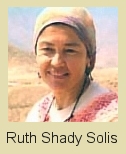 As Ruth Shady's team have uncovered Caral they have revealed a large central amphitheatre, three sunken plazas, a furnace designed to burn an eternal flame, apartment-style housing and other dwellings that occupy an area of some 160 acres. It is thought that as many as 10,000 people might have inhabited the site. Shady believes that Caral was the religious and administrative centre for a culture that built at another 17 sites that are still buried in the Supe valley and along the Pacific coast. She thinks that Caral is the most complex site and that it was the centre of a priestly society that flourished in the fertile Supe valley in ancient times. The significance of her find is its age. The unearthing of Caral by Ruth Shady could well qualify as the greatest archaeological discovery of the 20th century. Reeds in woven bags that were used to hold stones comprising the fill of the Caral pyramids have been definitively radiocarbon dated to as early as 2600 B.C. Shady believes that the site could be even older than this, because the reed samples used in dating, as reviewed and published in the journal Science, were not taken from what is probably the oldest area of Caral. Since it is around 5000 years old, Caral is older than any other city in the New World. 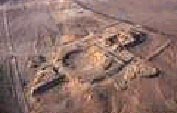 Importantly, the details of life there are not obscured by later structures or technologies built over the top of the old site. The excavations of Caral show no evidence of the use or knowledge of the wheel, writing, pottery, metal tools, or the cultivation of grain crops. However, sure signs of civilization are found in the monumental architecture, extensive urban constructions, and the existence of irrigation systems in the surrounding countryside. Importantly, the details of life there are not obscured by later structures or technologies built over the top of the old site. The excavations of Caral show no evidence of the use or knowledge of the wheel, writing, pottery, metal tools, or the cultivation of grain crops. However, sure signs of civilization are found in the monumental architecture, extensive urban constructions, and the existence of irrigation systems in the surrounding countryside.
Archaeologists now regard Caral as the closest thing to a missing link between a non-urban form of existence, in which people were nomadic or occupied small villages, and the precursor of the large cities we live in today. Some archaeologists think that Caral might be the only example of a true mother city that will ever be found. It provides a unique opportunity to find out why civilization started. This is one of the most important questions in all of archaeology, and Caral could help Ruth Shady and her team to answer it. However, the work of Knight, Lomas, and Butler suggests that there is likely to have been an even earlier civilization, all traces of which have been lost in the mists of time.
A Thousand Years of Peace
During the past 3000 years of recorded history humans have fought more than 5000 wars, with the 20th century having been the most bloody period of all. Given the seeming normality of war, it is not surprising that many archaeologists had subscribed to the view that civilization originated in response to the pressures of attacks by armed raiders. According to this notion, the development of agriculture enabled grain crops to be stored and food reserves to be built up at locations that then needed to be fortified and protected by standing armies. Fear of attack and plunder of food and valuables was thought to have been the initial motivation to build cities and fortify them with walls, battlements, and other defences. Ruth Shady does not appear to have been predisposed to finding evidence of weapons and fortifications at the mother city of civilization in the New World, but Jonathan Hass, of the Field Museum in Chicago, was a leading advocate of the theory that warfare drove ancient people to build cities. When he was invited to the site by Shady, Haas expected to find two things, evidence of stored food reserves that would have been vulnerable to plundering, and evidence of weapons, fortifications, and warfare. Caral did not yield any such evidence. To the contrary, the archaeologists excavating Caral have found no weapons of any sort, no art depicting warfare, no battlements, no defences anywhere in the city or the valley, and no sign of grain crops or food stores. Instead they have found a large central amphitheatre, evidence of an eternal flame, and a collection of beautifully carved flutes made from the bones of condors. Although they do not appear to have developed a system of writing, the people of Caral evidently composed and played music.
A Pre-Taker Economy
The archaeologists working at Caral have also discovered that its numerous inhabitants used an extensive irrigation system to grow crops such as squash, avocados, potatoes and beans. From the diggings, it is evident that cotton was extensively cultivated. Once harvested, some of the cotton was spun and woven into fine mesh nets that were then provided to the fishing villages on the coast, some 12 miles from Caral. In return for the nets the fishermen provided supplies of fish such as the anchovies and sardines that teemed in the cold Humboldt Current running down the coast of Peru. Caral enjoyed an abundance of food but it had no staple agriculture of the type that led to the development of the Taker mentality that Daniel Quinn writes of. Archaeologist, Michael Moseley, has studied the fishing economy of the coastal regions near the Supe valley. Commenting on the findings at Caral Moseley observed that, "What you don't have is the fancy artefacts and all the other bells and whistles." The digs at Caral do not yield a lot of the accoutrements of rank and personal wealth. There are finely worked beads but no hoards of personal possessions. "People are farming or fishing. You only get a focus on personal wealth with the onset of staple agriculture."
Significant Achievements
There are many points of significance about Caral. In its day, the city was the centre of a peaceful trading network that extended from the coast to the Andes and the forests of the Amazon. It was a spiritual place and its people built alcoves with dried-mud figurines in their homes, and burnt small sacred bonfires. Later civilizations did not occupy the site, but they apparently revered it and left gold and silver offerings at its perimeters and built temples on its outskirts. The scale of the pyramids constructed at Caral is evidence of significant architectural knowledge and organisational abilities. No celestial or solar alignments have yet been studied in relation to the six pyramids, but it will not be surprising if significant alignments are found to exist. Nor is it too far fetched to think that somewhere under the rubble covering the 160 acre site the excavators of Caral might one day come across a working cross of the type rediscovered by Crichton Miller. It is also not improbable that survey studies will reveal a standard unit of lineal measure, and that this will be shown to have been derived from sightings of Venus and 366 beats of a simple pendulum. The site at Caral is of the same age as the megalithic monuments studied throughout Britain and Western Europe by Professor Thom. All are 5000 years old. Just as no metal tools have been found at Caral, the megalithic people also lacked metal tools. Yet they used the megalithic yard in their constructions and, as Knight and Lomas have shown, they built stone circles that are not only capable of creating exact standards of measurement, but of also measuring such values as the inclination of the ecliptic and the circumference of the Earth.
In due course, there is one achievement of overriding significance that Caral might well provide. One great contribution or lesson that can be applied to the 2nd Renaissance. How to live in peace, with spiritual meaning, and without warfare, for a thousand years.
The Slave Labour Hypothesis
Despite the failure of the warfare hypothesis in explaining how humans first came to leave the simple life and develop complex, city-based societies, some archaeologists argue that the pyramids at Caral had to have been constructed by people who were made to do the job. In a TV documentary on Caral, one of the scientists interviewed expressed this notion very succinctly. He said, "You can't build a huge structure like that on the basis of consensus."This logic as long been applied to the construction of the Great Pyramid at Giza. Traditional egyptologists maintain that slaves were used to construct the Great Pyramid, as a tomb for the Pharaoh Khufu. One estimate is that it took one hundred thousand slaves thirty years to build the structure. Assuming that the construction technology required considerable manual effort, the arithmetic might be correct. Moving and accurately placing more than two million blocks of stone weighing an average of 2.5 tons each would require many workers. Although most egyptologists are adamant that only coercion could have caused ancient people to provide so much hard work, the hypothesis of slave labour is pure speculation. Despite its hypothetical nature, children in the present day are taught this information as if it is fact. Conversely, many real and verifiable facts about the Great Pyramid are not taught because they concern the sacred geometry contained in its design. These geometric relationships and symmetries are dismissed as coincidence. The reasons that the Great Pyramid is such a wonder are as much due to its amazing geometry as its scale and majesty. Crichton Miller believes that the structure was surveyed and aligned using a working cross. He contends that the relics found in the lower north shaft of the Great Pyramid, a granite ball, a double hook of metal, and a short length of wood that is considered to be part of a measuring rod, are all that remains of a working cross. Of the Great Pyramid itself Miller says,
"Some try to say that it was built by slaves, but it was not, it was built with the kind of love and devotion that can move mountains. Musicians find inspiration from the pyramid based on harmonics. Geometers find correlations that are astounding and encompass all the geometrical shapes possible, including the fibonacci spirals and platonic solids. Mathematicians argue about the right angled triangles and the use of Pi. It is a source of constant wonderment to all those who encounter it."
Divine Motivation
It might have been necessary to employ overseers with whips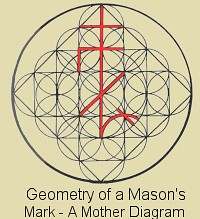 to motivate workers building a mere tomb, but the Great Pyramid is a divine structure. The motivation to build it was spiritual, and far stronger than any form of coercion could ever be. There are many divine structures that incorporate sacred geometry, but none were built with slave labour. The great cathedrals of Europe all employ the Golden Ratio and many contain pentagonal or fivefold symmetries. It was the Masonic Guilds, whose members were expert stone masons, having learned sacred geometry in Gnostic and Hermetic Mystery Schools, that built structures such as Chartres Cathedral, completed in ad 1260. to motivate workers building a mere tomb, but the Great Pyramid is a divine structure. The motivation to build it was spiritual, and far stronger than any form of coercion could ever be. There are many divine structures that incorporate sacred geometry, but none were built with slave labour. The great cathedrals of Europe all employ the Golden Ratio and many contain pentagonal or fivefold symmetries. It was the Masonic Guilds, whose members were expert stone masons, having learned sacred geometry in Gnostic and Hermetic Mystery Schools, that built structures such as Chartres Cathedral, completed in ad 1260. The Sultan Ahmet Mosque (the Blue Mosque) and the Suleymaniye Mosque, in Istanbul, are also examples of sacred structures that resonate with the harmonies and proportions of PHI and the geometry of the ancients. Both the mosques were built is only seven years (ad 1609-1616 and 1550-1557, respectively) by teams of Arab craftsmen that each built a section of the structure. It is not yet known whether the pyramids at Caral incorporate sacred geometry, but it is clear that they held spiritual significance for the people of the city, and the Supe valley beyond. Given a divine meaning, it would not have required any coercion to motivate the builders of the structures, their deep spirituality would have provided all the motivation required.
Back To The Future
The people of Caral had ample food to sustain them, they had cloth for garments, they had housing and shelter, they had peace and a collective culture in which personal wealth and the accumulation of possessions played no part. Above all, these people seem to have had meaning and purpose in their lives. From the evidence of an infant burial discovered at the site, they loved their children, and presumably they taught them the truth about their world and history, as they knew it. No one yet knows why they abandoned Caral, or where they went. However, what is known about them could provide present-day pioneers of the New Tribalism movement with clues on how to live with, and master, conditions of abundance that will exceed anything that has previously existed, even in the Supe valley 5000 years ago.
Whether the people of Caral were actually as peaceful, spiritual and contented as they seem to have been is not important. What is important about the civilization at Caral is that it was Pre-Taker. If we are to survive as a species, and build a Level 4 Civilization, we must find a way to live as Leavers, even with the knowledge, and available technologies, to provide us with anything we could ever want.
Telling It Like It Is
One of the first things that we must do, is to start teaching our children the truth. Not a mishmash of false hypotheses that are passed off as fact, but the truth as we know it. We must distinguish between verifiable fact and hypothesis, and never pass one off as the other. We must admit what is not known. Despite the rapid advance of knowledge there are many things that remain a mystery to us, these range from big questions such as the extent of the universe, to more mundane ones, such as how cats purr. Many courses will need to be revised, many books will need to be updated or pulped. But the expunging of false or misleading information from learning and information sources needs to be done, and the sooner the better. In cases in which government or religious education systems and institutions resist a move to honesty in learning, and where academics resist the scrapping of deficient texts they have authored, there must be an option to place children and adult students in an alternative learning system. Home schooling will be resisted by most governments, not because it might be of any lesser standard, but because it is sure to cut across what George Orwell called "the official truth". Internet based education will be discouraged for similar reasons. But, ways must be found to make the real truth accessible to all young people. Their possession of this knowledge will be a prerequisite for establishing a Level 4 Civilization.
A Language In Knots
The Inca ruled an empire that covered the Andean region, from what is now Colombia to Chile. At its height the Inca empire extended for 3,500 kilometres, north to south. Although they build an extensive network of roads and large cities, the Inca are said to have done it all without a written language. This is most unusual for such a large empire that developed such a complex system of government. In fact, according to Douglas Robertson's ideas about the nature and scale of the information required for a Level 2 Civilization, it is most unlikely. (See sub-heading [13] of the 2nd Renaissance freesite.) How could the Inca have managed to establish and govern their empire, between 1200 and 1536 A.D., without written records? How could they have controlled a vast system of granaries and warehouses, collected and recorded taxes, etc, using only their memories? It would have been impossible. But until now, that is what modern archaeologists have asserted. The Inca did not have a written language, that's the conventional wisdom. 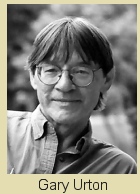 Gary Urton is Professor of Pre-Colombian Studies at Harvard University. He believes that the Inca did have a non-verbal form of communication. Moreover, Professor Urton's research indicates that the record keeping of the Inca involved a sophisticated binary code, that is in at least one respect more sophisticated than that used by modern computing science. Gary Urton is Professor of Pre-Colombian Studies at Harvard University. He believes that the Inca did have a non-verbal form of communication. Moreover, Professor Urton's research indicates that the record keeping of the Inca involved a sophisticated binary code, that is in at least one respect more sophisticated than that used by modern computing science.
The key to unravelling the puzzle of how the Inca kept records and communicated non-verbally lies in the patterns of knots, the weaving involved,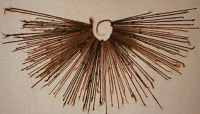 and the colours used in the objects known as khipu. Although it was known, from studies in the 1920s, that some khipu used arrangements of knots that could store calculations, modern science continued to regard the khipu as being largely "decorative" in nature. Yet, there is a record of the Spanish conquerors capturing an Inca who tried to hide a khipu. When questioned the Inca told the Spanish that the object recorded everything done in his country. and the colours used in the objects known as khipu. Although it was known, from studies in the 1920s, that some khipu used arrangements of knots that could store calculations, modern science continued to regard the khipu as being largely "decorative" in nature. Yet, there is a record of the Spanish conquerors capturing an Inca who tried to hide a khipu. When questioned the Inca told the Spanish that the object recorded everything done in his country. Khipus are made of cotton or wool. A main cord carries various pendants, each with its own set of knots and ties. By analysing the patterns in the khipus that have been preserved in museums around the world, Gary Urton discovered that there are seven points in their making where there is a simple choice between two possibilities. Theoretically, there is a seven-bit binary code available to the maker of a khipu. In addition to a basic seven-bit code, that could yield 128 permutations, the khipu makers used 24 colours of cord. This means that there are 1,536 permutations available to convey information. Professor Urton says, "Each element could have been a name, an identity or an activity as part of telling a story of a myth. I think a skilled khipu-keeper would have recognised the language. They would have looked and felt and used their store of knowledge in much the same way we do when reading words." Until Professor Urton and his colleague, Carrie Brezine, are able to correctly decipher the code of the knots, twists and colours in the khipu, the notion of a unique, three dimensional binary language, remains unproven. However, work is proceeding and Professor Urton is hopeful that a further 32 khipu that he recently discovered in an Inca burial site will prove helpful. The newly discovered artefacts are from the period of the Spanish conquest, and it might be possible to match some of them to Spanish documents from the same period. It is known that the Spanish worked quite closely with some Inca khipu-keepers. Urton says, "We have for the first time a set of khipu from a well-preserved and dated archaeological site, and documents that were being drawn up at the same time." Without a reliable translation of the khipu it remains difficult to convince sceptics that the khipu are anything more than memory aids for storytellers. With the hoped for breakthrough in translation will come evidence that the complex knotting patterns of the khipu are truly examples of the invention and use of a binary code more than 500 years before the development of computers. Urton believes that, "It can give us a completely different perspective on questions of literacy, on the nature of signs."
Why Study Sacred Geometry?
The importance of learning geometry as the ancients taught it is to cut through the abstractions that man has overlaid on the natural proportion and order of the universe. It is not a new-age hippie reason, but a serious pathway to a full comprehension of the truth about numbers.
Geometry does not need numbers in the sense of "one", "two", "goo", "zoo". It works with lengths and proportions. It is practical to construct the patterns of sacred geometry using only a pencil, a drawing compass, and a straight edge. Just as the relationships between notes and tones in music are independent of any contrived number system, so are the lengths, proportions, and angles of geometry. Indeed, geometry was described by the 18th century German poet and natural philosopher, Johann Wolfgang von Goethe, as "frozen music."
Robert Lawlor's wonderfully illustrated book, Sacred Geometry - Philosophy and Practice, provides some very revealing insights into the history of our present-day numerical conventions. Lawlor shows how the adoption of a decimal system that includes zero was significant in masking the properties of the underlying natural numbers. Although both the ancient Egyptians and the Romans used decimal systems, they had separate symbols for each unit of growth, tens, hundreds, thousands, and so on. During the twelfth century the works of the Arab mathematician, Al-Gorisma, were translated into Latin. Both the originally Indian numerals, 1 through 9, and the concept of zero, began to influence Western thought and mathematics from that time. Due to the practicality it afforded to calculations in commerce, zero together with the Arabic numerals, was quickly adopted by the merchant class in Europe.
Some excerpts from Lawlor's book explain the way in which zero changed mathematics. - "The consequences were enormous. First or all, within the structure of arithmetic itself, the additive basis of calculation had to be cast aside. Formerly the addition of one number to another number always produced a sum larger than either of the original numbers. This was of course nullified by the utilization of zero. Other laws of arithmetic were also altered, so that we are now able to have operations such as the following: 3+0=3, 3-0=3, 03=3, 30=3x10, but 3x0=0, and 3/0=0 (???).
Here logic completely breaks down. The illogic of the symbol was accepted because of the convenience it afforded to quantitative operations. Yet this breakdown of the simple, natural logic of the arithmetic structure allowed a complicated mental logic to take its place and invited into mathematics a whole range of numerical and symbolic entities, some of which have no verifiable concept or geometric form behind them. Arising from the sixteenth century onwards, these entities include relative numbers (i.e. negative quantities such as -3); infinite decimal numbers; algebraic irrational numbers (numbers such as e, the basis of logarithms, which satisfy no rational algebraic equation); imaginary numbers such as the square root of -1; complex numbers (the sum of a real number and an imaginary number); and literal numbers (letters representing mathematical formulae). The invention of zero permitted numbers to represent ideas which have no form. This signals a change in the definition of the word 'idea', which in antiquity was synonymous with 'form', and implies geometry." - "The 'western' rationalistic mentality negated the ancient and revered spiritual concept of Unity, for with the adoption of zero, Unity looses its first position and becomes merely a quantity among other quantities. The advent of zero allows one to consider anything below the quantitative number series as nil or of no account, while anything beyond the quantitatively comprehensible range becomes an extrapolation subsumed under the word God and deemed religious or superstitious. Hence zero provided a framework in western thinking for the development of atheism or negation of the spiritual."
- "With zero we have at the beginning of modern mathematics a number concept which is physically misleading and one which creates a separation between our system of numerical symbols and the structure of the natural world. On the other hand, with the notion of Unity which governs ancient mathematics, there is no such dichotomy. "
- "...unthinkable though Unity may be, both reason and spiritual experience compel the traditional thinker to place it at the beginning. Everything that exists in his mathematical problem or in his universe is a fraction of the unknown One, and because these parts can be related proportionately to one another they are knowable."
- "Unity is a philosophic concept and mystic experience expressible mathematically. The Western mentality, however, withdrew its discipline of acknowledging a supra-rational, unknowable mystery as its first principle. But in rejecting this reverence to a single unknowable unity, our mathematics and science developed into a system requiring complex, interconnected hypotheses, imaginary entities such as those mentioned above, and unknown x quantities which must be manipulated, quantified or equalised as in the algebraic form of thought. So the unknown appears not just once but at every turn, and can be dealt with only by seeking quantitative solutions."
- "Our present thought is based on the following numerical and logical sequence:
-5, -4, -3, -2, -1, 1, 0, 1, 2, 3, 4, 5 With zero in the centre, there is a quantitative expansion 1, 2, 3, ... and our sense of balance requires having -1, -1, -2, -3 ... on the other side, giving a series of non-existent abstractions (negative quantities) which demand an absurd logic. The system has a break-point, zero, disconnecting the continuum and dissociating the positive numbers from the negative balancing series."
- "In the ancient Egyptian numerical progression, beginning with one rather than zero, all the elements are natural and real:
1/5, 1/4, 1/3, 1/2, 1, 2, 3, 4, 5 All the elements flow out from the central unity in accordance with the law of inversion or reciprocity. The Egyptians based their mathematics on this simple, natural series of numbers, performing sophisticated operations with it for which we now need complex algebra and trigonometry." 
- "...In terms of the orthodoxy of ancient mathematics, the symbols of mathematics should reflect the realities they describe. With zero and the array or merely mental and statistical signs which followed it, we are very far from having a system of mathematical symbols which corresponds to the pure geometric order of living space."
In the words of the mathematician Leopold Kronecker: "God made the integers and all the rest is the work of man."
Within a no inevitable 2nd Renaissance, free cities and regions will provide education options that enable all members of society to study sacred geometry and ancient knowledge. This will greatly assist these centres to adapt to and embrace the ideas that will drive science and technology in the 21st century, and lead to the generation of the levels of abundance necessary in a leaver-giver society. Without the deep insights that such studies can bring, people will be likely to find it harder to understand and apply the right knowledge. All 'educated' people will need to re-learn and adapt much of the 'truth' they have accumulated during the industrial age. Children, on the other hand, will need to begin their education on a sound footing from the start. It should be quite practical for them to be fluent in new knowledge by the time they are twelve years of age. The author and management consultant, Kenichi Ohmae, feels that Japan will be at a disadvantage in the new age, because of an inability to quickly free regions from central control. But that won't be the deciding factor in transforming the economy. The crucial element will be the capacity of the people to be able to accept discovered truth when it contradicts 'modern' teaching. In this regard traditional societies like Japan might have more affinity with ancient knowledge and truth than nations that have been deeply 'educated' in the truth of the West. Although Japan is a thoroughly modern industrial power it has probably retained its traditional culture better than any other country has managed to do. Combined with a 2nd Renaissance education system, their more receptive attitudes to surprising new knowledge, that accords with many ancient rituals, might be a decisive advantage for Japan. It could be the ease with which the various countries, that are presently nation states, can reintroduce ancient teachings and forms of thought into their education systems that becomes the decisive factor in preparing for a Level 4 Civilization. Japan might have centralist bureaucracies to overcome, but so do all other nations. One difference between countries such as the USA and Australia, and those such as Japan and India, is that the latter have knowledge traditions, in mathematics, music, geometry, and astronomy, that stretch back thousands of years. All America and Australia have in this regard is materialistically oriented theories that evolved in Europe during the past two centuries. Most of these notions now need to be unlearned. That could prove painful, but it will have to be done.
Why Study Music?
It is important to study music for the same reasons that it is necessary to study sacred geometry. We need to rediscover what the ancients knew, and to integrate those insights with the most recent findings in fields such as physics, cosmology, biology, and sociology. This is not the same as learning to play a musical instrument or to appreciate musical styles and performances. Nor is it the same as studying sound in a laboratory. This study of music is about the way sound is organised in the form of music and of the proportions, progressions and inversions involved. Again, geometry is involved, and so are elements of the divine and metaphysical.
The cover notes of the book, The secret Power of Music, by David Tame, describe his work as follows. "Drawing upon the wisdom of ancient civilizations as well as contemporary scientific data. David Tame offers a challenging and timely alternative to the widely-held modern notion that music is an intangible art form of little practical significance."Indeed, as Tame and others who have studied the geometric order of music have found, music is ultimately about vibrations and vibrations are the basis of all matter. Young people who will become the scientists and technologists driving new abundance in this century will need to develop such understanding. That is why free cities and regions will include this knowledge in their education systems.
Here are some excerpts from Robert Lawlor's Sacred Geometry. - "A mediating proportion can be defined as A group of three unequal numbers such that two of their differences are to each other in the same relationship as one of these numbers is to itself or to one of the other two numbers.
This strange mathematical 'koan' contains the formula for the three major medians, the Arithmetic, the Geometric and the Harmonic." - "Each proportion has a number of characteristics which are peculiar to it. For example, the arithmetic proportion shows an equality of difference, but an inequality of ratio. Thus, in the arithmetic proportion: 3, 5, 7,7-5=5-3 but 7/5 does not equal 5/3
A geometric proportion on the other hand, is characterised by an equality of ratio but an inequality of difference. Therefore in the geometric proportion: 2, 4, 8, 4/2=8/4 but 4-2=2 does not equal 8-4=4The most important and mysterious character of the harmonic proportion is the fact that the inverse of every harmonic progression is an arithmetic progression. Thus 2, 3, 4, 5, is an ascending arithmetic progression while the inverse series, 1/2, 1/3, 1/4, 1/5, is a descending harmonic progression. In music it is the insertion of the harmonic and arithmetic means between the two extremes in double ratios - representing the octave double - which gives us the progression known as the musical proportion, that is 1, 4/3, 3/2, 2. In other words, the arithmetic and the harmonic means between the double geometric ratios are the numerical ratios which corresponds to the tonal intervals of the perfect fourth and the perfect fifth, the basic consonances in nearly all musical scales. The basic proportional structure which contains the axioms for our primary mathematical operations is also the basic proportional structure for the laws of music."
Today, many people believe that musical scales are human inventions. Some attribute their development to the ancient Greeks or to mathematicians in India. But the truth is that such scales are natural phenomena, they have been discovered by humans, such as Pythagoras, - not invented by them. During the 20th century, state education systems and the media presented music as an art form. In reality music is at the core of the science of harmonics. An understanding of musical patterns and geometries leads to an understanding of matter and the cycles of the universe. As humanity continues to expand knowledge exponentially, into the 2nd Renaissance, knowing about the harmonic nature of everything there is will rank as one of the most vital insights a scientist or technologist can bring to bear in their work.
There is another insight to be achieved through the study of sacred geometry and musical vibrations, it is that we humans are not above other living things. All that our intellect enables us to do is discover the natural order of the universe. We can no more change that order than can horses or pigs. It is sheer arrogance to believe, as takers implicitly do, that we humans have a 'right' to exploit nature and unfettered power to control it. Just as Peter Plichta's work on prime numbers and the structure of the elements reveals a design that requires a designer, (See sub-heading [36] of the 2nd Renaissance freesite), so too does the existence of the natural structure of scales and harmonics strongly indicate the existence of a 'creator' intelligence higher than our own.
In The Secret Power of Music, David Tame writes: - "In ancient times sound itself, the very basis of all music, was thought to be intimately related in some way to non-physical and sacred dimensions or planes of existence. Why was this? Because audible sound was considered to be but an earthly reflection of a vibratory activity taking place beyond the physical world. This vibration was more fundamental and nearer to the heart of the meaning of things, than any audible sound. Inaudible to the human ear, this Cosmic Vibration was the origin and basis of all the matter and energy in the universe."
- "In modern times, the physical sciences are now arriving back at this original point of departure. Once again, science is beginning to suspect that matter is all composed of one fundamental something, and that the frequencies or rhythms of this something determine the specific nature of each object and atom."
- "Certainly music is very much physical, and not at all abstract or insubstantial. The air vibrations of its sound are not only real and measurable, but capable of shattering glass. Music and other forms of sound can cause all kinds of sympathetic vibratory resonances within objects at a distance. ....Rhythm too can be all too real a force. Military experience has taught from centuries past that when troops marching in unison need to cross a bridge, the commanding officer should give the order for them to break step, for the effect of the marching "ri', lef', ri', lef'" rhythm has more than once led to the collapse of such constructions."
- "To the question, 'Does music affect man's physical body?' modern research replies in the clear affirmative. There is scarcely a single function of the body which cannot be affected by musical tones. The roots of the auditory nerves are more widely distributed and possess more extensive connections than those of any other nerves in the body. ....Investigation has shown that music affects digestion, internal secretions, circulation, nutrition and respiration. Even the neural networks of the brain have been found to be sensitive to harmonic principles. .....Researchers have discovered that consonant and dissonant chords, different intervals, and other features of music all exert a profound effect upon man's pulse and respiration - upon their rate and upon whether their rhythm is constant, or interrupted and jumpy. Blood pressure is lowered by sustained chords and raised by crisp, repeated ones."
- "What of the effects of music upon non-human life? ...In one experiment conducted by psychologists, rats were given the free run of two separate but connected boxes. Music was 'piped through' into each of them - Bach into one, rock into the other. Though the two boxes were identical and all other conditions except the music were equal, the rats all spent their time in the Bach box. To test further the purity of the experimental conditions, the music broadcast into the two boxes was changed around; and gradually the rats all moved into the other box. Such an experiment does not, of course, mean that the creatures preferred or 'comprehended' Bach on the same level that a human can. but the result does indicate that at some level, the degree of pleasure or pain which the rats experienced in the two boxes was tipped in favour of the master of Baroque."
- "In the investigation of the effects on music upon life, a number of preliminary experiments have been conducted with plants. Paradoxical as it may seem, music's effect upon the more primitive vegetable kingdom is one of the most convincing methods of all for proving that music does affect life, including human life. For experiments conducted with humans, and even, to some extent, with animals, have the extra factor of the mind to contend with. ...the effect upon the body may have been caused by the mind's subjective reaction to the music heard. In the case of plant-music research, however, psychological factors cannot really be said to be present. If music can be shown to affect plants, then such effects have to be due to the objective influence of the tones directly upon the cells and processes of the life-form."
- "Dr T. C. Singh, head of the Botany Department at Annamalia University, India, has also conducted research into the effects of music on plants. He discovered not only that constant exposure to classical music caused plants to grow at twice their normal speed, but also went on to find what seemed to be one of the main causes of this accelerated growth. The sound waves of a musical instrument, Dr Singh found, cause increased motion in cellular protoplasm. (Protoplasm is the basic material of which all plant - and animal and human - life is made up.) ....In Dr Singh's experiments, the violin was found to be one of the most life-enhancing instruments of all. Altogether, life-enhancing characteristics as a result of music were shown in balsam, sugar cane, onions, garlic, sweet potatoes and other plants besides.
Yet, perhaps the most interesting and significant of all of Dr Singh's findings was that later generations of the seeds of musically stimulated plants carried on the improved traits of greater size, more leaves, and other characteristics. Music had changed the plants' chromosomes!" - "Let us recall that besides the ancients' belief that music affects the body, emotions and mind of man, they also claimed that music's power was objective, not subjective. That is, they claimed that different types of music are inherently good or inherently bad; that certain combinations of tones are objectively life-changing and evolutionary in nature, while others are unhealthy and dangerous.
The question of what constitutes good or bad music can be answered in just eight words: good music gives life; bad music gives death. There is more to life and death than the two sides of the grave: every moment of music to which we subject ourselves may be enhancing or taking away our life-energies and clarity of consciousness, increment by increment." - "A recent teenage fad was that of taking soft eggs to rock concerts and placing them at the foot of the stage. Midway through the concert the eggs could be eaten hard-boiled as a result of the music. Amazingly few rock fans wondered what that same music might do to their bodies."
As evidence of the all-pervasive nature of musical patterns and proportions in our collective psyche there is also the example of the Ur-song. Here is some of what David Tame writes of it. - "The intervals and harmonics of music, mirroring the geometry of the heavens, may also be present in some mysterious way within not only the physical form of man, but also within the patterns of his psychology. It has often been pointed out, and even entire books written on the subject, that the architecture of previous times often displayed ratios and proportions such as are found in the intervals of music. From the constructions of ancient Greece to those of the more recent Gothic periods, there exist many examples of buildings based almost entirely upon the intervals of octave, fifth, fourth and so on. The same ratios are also found in the works of the grand master painters. At times these ratios in art and architecture occur with a frequency and precision that can only be conscious and deliberate; at other times it seems likely that the ratios were included unconsciously, because they seemed 'right'."
- "That such ratios occur unconsciously seems to be supported by the phenomenon known as the Ur-song. This phenomenon takes us deeper still into the framework of the human mind. For Ur-song is the name given to a fundamental type of melody that infants everywhere in the world seem to sing quite spontaneously, without having learned it from their parents or the culture around them.
On the face of it, there is no obvious reason why children, if they produce melodies spontaneously, should not begin with any of the infinite variety and number of different tones and tone-relationships. The notes of the Western diatonic scale are, after all, but a few points on a spectrum of tone-frequencies that actually includes an infinite number of points or minutely-different pitches. Yet in all lands, children from the age of eighteen months to two and a half years have been found to spontaneously sing melodic fragments with the intervals of second, minor third, and major third. Thence, in their second and third years, while systematically exploring the use of these intervals in what may be a very important developmental psychological process, children then go on to include fourths and fifths. (A descending third is a pitch difference or interval such as that between 'this' and 'old' in the tune 'This old man...'. An example of a fourth is the interval between 'Don-' and '-ald' in 'Old MacDonald had a farm'.) Only at the age of three does the particular musical style of their own culture begin to influence them, thus putting and end to their spontaneous and independent expressions of the Ur-song. (Ur is a German prefix for original, primeval.)" - "In 1973 the composer and conductor Leonard Bernstein, in his Charles Eliot Norton lectures at Harvard, described the Ur-song of the world's children as an archetypal pattern. He said that the song consists of a repetitive, descending minor third, often accompanied by another descending step to a fourth. In his opinion, Ur-song is the joint product of the physical laws of harmony, and of the innate, genetic pattern of all human beings.
The concept of the diatonic scale being written into the genetic pattern of man is in itself full of implications. Yet we should not always immediately assume that all such innate abilities are primarily linked to genes, chromosomes, etc. for to do so is to fall into the trap of materialism. Ur-song may be demonstrating to us that the thought processes and the natural flow of consciousness (which is so uninhibited and spontaneous in infants) are themselves somehow linked to the harmonic principles which the ancients believed to be the foundation of the universe."
Until the musician David Hindley studied it, the song of the skylark was regarded as simply a beautiful sound. Nobody suspected that this little bird was actually singing recognisable music. When he slowed down a recording of the birdsong,  Hindley found that he could distinguish individual musical notes. The song was highly compressed; from forty eight seconds of it he was able to extract almost thirteen minutes of sheet music. This could be played like any other piece. More than that, Hindley found that the song of the skylark used the same principles of composition as human music, and that the particular birdsong that he transcribed bore a striking resemblance to structures in Beethoven's Fifth Symphony. Hindley found that he could distinguish individual musical notes. The song was highly compressed; from forty eight seconds of it he was able to extract almost thirteen minutes of sheet music. This could be played like any other piece. More than that, Hindley found that the song of the skylark used the same principles of composition as human music, and that the particular birdsong that he transcribed bore a striking resemblance to structures in Beethoven's Fifth Symphony. When he studied the song of the woodlark, David Hindley found that it changed tune in keeping with the rules of classical sonata form, and contained similarities to J. S, Bach's 48 Preludes and Fugues. Scientists are now discovering that many animals communicate using compressed sounds, and that the brains of the receivers seem to be able to expand the messages within barks or squeaks and comprehend them. However, the discovery of classical musical structures within the songs of birds is quite astounding. It indicates that we humans are not the only creatures to use musical scales and compose melodies.
Vibrations and Matter
"Nothing is 'solid', nothing is impenetrable, it is all vibrations; all energy. Everything emanates from the same source.Everything is a voice or speech resounding over the world, through the entire universe, through micro cosmos and macro cosmos. It vibrates through the shining of the stars. It shines in the orbits of the planets. It is whispered through the gentle breeze and is murmured in the depths of the forest. It is whistled through the sirens of the factories and is heard in the noise of the machines. It is sung over the cradle and spoken at the grave. It is vague feeling or notion, wisdom and belief. It is knowledge, recognition and hope. It is death, resurrection and life. It is colour, vibration and light. It is everything that can in any way be sensed, thought and experienced." ... Martinus It is worth learning geometry as the ancients taught it because music is geometric. It is worth studying music in a geometric sense because this uncovers truths about vibrations and patterns of vibrations. Vibrations are important because all matter is formed from them. The 2nd Renaissance involves an explosion of knowledge and discovery that is taking humanity beyond the old 'drop in on your foot' materialistic and mechanistic view of the world and the universe beyond. The 21st century talent collectives that will build new technologies to defeat scarcity and create abundance will do most of their work in the realms of invisible vibration patterns. All young people, both boys and girls, now need to learn within these fields of knowledge, because humanity's future will be built there.
Ernst Chladni (1756-1824) was a German physicist who is credited with founding the study of acoustics. He lightly covered glass or metal plates with fine sand and studied the harmonic vibrations caused by drawing a violin bow across their edge. 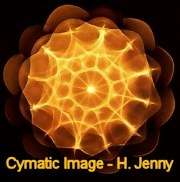 The patterns that formed in the sand on the plates made the sound waves visible and enabled them to be studied. The patterns that formed in the sand on the plates made the sound waves visible and enabled them to be studied. Hans Jenny (1904-1972) was a Swiss medical doctor and natural scientist. Jenny extended the technology of studying sound waves by inventing what he called the tonoscope. This instrument used crystal oscillators to enable the operator to set specific frequencies and amplitudes. Jenny placed various substances, such as sand, iron filings, water, and viscous liquids, on vibrating plates and studied the patterns produced by the sound waves. Since the tonoscope did not use any electronics it also afforded Dr Jenny the opportunity to directly view the physical images of vowels spoken by the human voice. He termed the new branch of science, Cymatics - the study of waves and vibrations.
The image above was produced by Jenny's tonoscope when a specific tone was applied to water. The amazingly geometric pattern below was the result of sending a tone through turpentine oil. 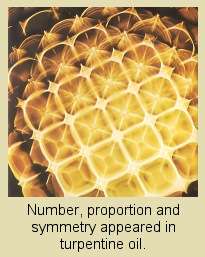 It is hard to look at these patterns and not conclude that geometry is, in fact, 'frozen music' They give considerable credence to the assertion that everything is vibrations, that nothing is really 'solid', and the 'thing' that you can drop on your foot or trade in the marketplace, is really a wonderfully geometric pattern of electromagnetic energy. It is hard to look at these patterns and not conclude that geometry is, in fact, 'frozen music' They give considerable credence to the assertion that everything is vibrations, that nothing is really 'solid', and the 'thing' that you can drop on your foot or trade in the marketplace, is really a wonderfully geometric pattern of electromagnetic energy. When the tone or harmonic is changed the patterns on the tonoscope change. But there is always observable evidence of number, proportion and symmetry. If everything is composed of vibrations, and if there is always geometric and numerical structure involved, Einstein's belief in order - that nothing happens by chance in nature - appears to be have been correct. The intervals and order of musical scales will always govern the infinite number of patterns that emerge. The numerical order of the Prime Number Cross, which Peter Plichta has shown to regulate the structure of the chemical elements is then a manifestation of this reality. God's secret formula is numerical and harmonic. Hans Jenny's images give the lie to the old assertion that, "There are no straight lines in nature". At the fundamental level of the vibrations that give form to what we perceive as matter there are, it seems, only lines, angles and arcs. Thus, straight lines are everywhere in nature, just look at the two patterns here if you doubt it. The first time that physicists were able to gaze at the structure of an atom, using an electron microscope that magnified the structure 260 million times, they saw geometric patterns. Despite the fact that nothing like the structure or mechanisms postulated by Niels Bohr has ever been observed within atoms - only geometric order - institutionalised science persists with using and teaching the Bohr model of the atom, even to the present day.
Interestingly, Jenny found that although there is no similarity between the spoken vowels of our modern languages and the patterns produced on the tonoscope, pronouncing the vowel sounds of the ancient Hebrew and Sanskrit languages caused the sand on the plate to take the shape of the written symbols for those vowels!
Hans Jenny's wonderfully illustrated book, Cymatics, was first published in 1967 and continues in print today. In it he voices the following impression gained from his extensive work. - "The more one studies these things, the more one realises that sound is the creative principle. It must be regarded as primordial. No single phenomenal category can be claimed as the original principle. We cannot say, in the beginning was number, or in the beginning was symmetry, etc. These are categorical properties which are implicit in what brings forth and what is brought forth. By using them in description we approach the heart of the matter. They are not themselves the creative power. This power is inherent in tone and in sound."
Although this conclusion was surprising to most people, it should not have been. No less a theoretical physicist than Albert Einstein had already said: - "On such things as matter we have all been wrong, what we have called matter is energy, whose vibration has been so lowered as to be perceptible to the senses. There is no matter."
What Can We Learn From Living Megalithic Cultures?
Chris Knight and Alan Butler are correct when they note a complete lack of written records about the lives, beliefs, and knowledge of Megalithic societies - those that would have come into contact with and learned from the 'Watchers'. However, there are places in the world where this information has been largely preserved through meticulous rote memorisation and 'handing down' processes. Australia is such a place. There are still indigenous people here who are living knowledge banks of the Megalithic history and experiences of their tribal ancestors. In the past 200 years of European occupation few people have taken the time to listen to present-day tribal people, or believe their myths and legends. Now is the time to do so, for the modern world needs to rediscover much of the wisdom they can offer.
Most archaeologists would regard the original inhabitants of Australia as having been Neolithic people; those who used ground and polished weapons during the late Stone Age. But I quite deliberately describe the ancient culture in Australia as Megalithic. The latter term is given to cultures that erected megaliths and 'monuments' like Stonehenge, and that is exactly what someone did in Australia thousands of years ago. Whether it was the ancestors of today's tribal Australians who were responsible for the construction or another race altogether, their handed-down stories should contain information that can help to fill in the many gaps in our knowledge of prehistory.
It is unlikely that we will discover usable information from an ancient super-science by studying the knowledge that has been handed-down through thousands and thousands of generations of indigenous Australian peoples. We will be able to recognise the science that we already know in their ceremonies and stories, but we won't be able to separate out the science we don't know about - even although it might well be there. At least one story, of the Adnyamathanha people from the northern Flinders Ranges in South Australia, suggests that they knew that the Earth is round, but to recognise this we also need to know that we live on a sphere. It is quite possible that the narratives, ceremonies, and particularly the music and tunings of tribal Australians contain science that we won't recognise - because we don't know it yet !
We can learn much more from Aboriginal spirituality. For indigenous Australians have an affinity with the Earth and their past that consequently raises their consciousness and predisposes them to a reflective, story-telling existence, rather than the acquisitive, combative ethos of most European descended people. Aboriginal Australians are taught, within their culture, to regard all life as one interconnected and interdependent system that traces back to great Ancestor Spirits of the Dreaming. This makes theirs a Leaver ethos whereas we of Western education and origins have fallen into a Taker ethos that can lead us nowhere; except to our own extinction. Science now understands that 19th century models of nature, that emphasised the ruthless extermination of rivals, were mistaken. A modern understanding of ecosystems and symbiotic relationships leads to the conclusion that cooperative models predominate in both the plant and animal kingdoms. However, big business and big government thinking remains locked into the old combative models, in which human enterprises and institutions are continually at war with each other and the planet at large. These are dead-end mindsets that cannot lead us to a higher, more advanced level of human civilization. War is not found in nature, only coexistence models succeed there. Tribal people with traditions that go far back in time have always understood this fact. We need to relearn this reality, before it is too late and takerism destroys the Earth.
A Clash Of Cultures In Australia
A little over 200 years ago, in 1788, the British government began an invasion and occupation of the Australian continent that was to lead to a clash of Leaver and Taker cultures that continues to this day. So far, the indigenous people have not fared well at all in this unnecessary confrontation. In the early days of 'settlement' Aboriginal people were decimated by introduced diseases to which they had no immunity; hunted down and clubbed to death by settlers on horseback while trapped in the corners of newly fenced paddocks, given bags of flour and sugar that had been laced with strychnine poison, and otherwise subjected to deliberate genocide. Of these facts there is absolutely no doubt, clear documentation of such atrocities exists. No treaties were ever reached with any of the various Aboriginal nations. The original inhabitants of Australia were simply dispossessed of their land and human rights by an imported Rule of Law that was ruthlessly applied in the favour of the invading Takers.
Today, indigenous Australians are still dying in droves; of curable illnesses, of the consequences of poor sanitation, of 'suicides' while in police custody, and of alcohol and other substance abuse. Nothing will change in this regard until thinking changes and, to date, there is no sign of that happening. If you were to walk into a bar in any Australian city or town and proclaim that all present were racists you would be likely to be beaten to a pulp by the 'Christians' you had disturbed. While the average non-indigenous Australian vehemently denies any charge of racism the majority vote in Australia has, for some 200 years, elected governments that were and are racist. Otherwise they would have, long ago, addressed the issue of land rights and acted to preserve the status and dignity of the first Australians.
This freesite is not focussed on human rights or racial inequalities issues in Australia (perhaps another will be), however the above background is relevant to the following story of the wanton destruction of an Aboriginal 'Stonehenge' in South Australia.
The Aboriginal Stonehenge At Emu Field
In 1953 Len Beadell, who has a highway named after him in South Australia, 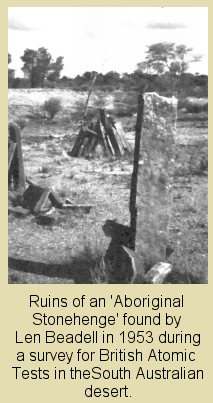 was busy surveying the land around the site of the first British atomic test at a location called Emu Field (the second and better known site was Maralinga). Beadell was astonished to come across a Megalithic ruin that he described as follows: was busy surveying the land around the site of the first British atomic test at a location called Emu Field (the second and better known site was Maralinga). Beadell was astonished to come across a Megalithic ruin that he described as follows: 
The land around the stones and the atomic test sites to the north of the Woomera rocket range was originally occupied by the Kokotha Nation (Aboriginal people did not 'own' land they believed that they belonged to it, rather than it to them). In 1988 mining commenced at Roxby Downs which was in the area of the Aboriginal Stonehenge. The Kokotha people were distressed by both the uranium mining and the destruction of their heritage. The following excerpts of an address by Joan Wingfield to The World Uranium Hearing in Salzburg, in 1992, are taken from a WWW source. - "... I'd like to start back in the 1950s when the Kokotha people were forcedly removed from their lands because of the atomic bomb testing and because of the testing of rockets at Woomera. At that time, the Kokotha and other Aboriginal Australians weren't citizens of the country, so we didn't have any rights. Because we weren't citizens that meant that we couldn't own land, it meant that we couldn't go to school, it meant that we couldn't get a job. So in 1966/67 there was a referendum where the Australian people voted to give us Aboriginal people citizenship rights. So, up until that stage we've been really powerless to do anything about our struggle. After that time we're still pretty powerless because we've had 150-odd years, 160-odd years to catch up on learning on non-Aboriginal ways.
In 1991, the Kokotha became concerned about mining activities at Roxby Downs. And this is basically when the Kokotha started to get back together, because we were spread all over South Australia for thousands of miles. So the difficulty came to protect the sites at Roxby downs because we weren't all in one group. ... We went to the mining companies and to the South Australian Government and we told them that we had traditional interests in that area and that we'd like the sacred sites and the lands there protected. The government and the mining companies blamed us, the victims, for not being in that land. They said, you haven't lived in that area for so many years, so you haven't got a right to talk about Roxby Downs." - "First of all, I'd like to say that 200-odd years does not give them the right to tell us that we have no right to talk about that land. it doesn't give them the right to deny us our cultural heritage, and I'm here to protect what's left, what hasn't been destroyed at Roxby Downs. I'm here to tell people that we have an interest in Maralinga even though it's been contaminated by the atomic bomb testing.
According to South Australian law we had to help do the environmental impact statement, we had to do an anthropological complement.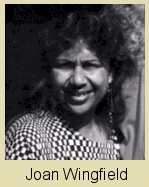 For a long time the government would not give us any money to do this. When we eventually got it done, we had to have what we said in that report verified by a white anthropologist. In other words, we had to have a white anthropologist saying what the Aboriginal people are saying about our sites and our lands is true. Which is a big insult ! We know what we're talking about, we have always known that, we've passed it down from generation to generation, so why should we have a non-Aboriginal verifying that our culture and what we say about it is true? Well, they finally accepted it and the anthropologist said "yes", not surprising to us, what we said was true." For a long time the government would not give us any money to do this. When we eventually got it done, we had to have what we said in that report verified by a white anthropologist. In other words, we had to have a white anthropologist saying what the Aboriginal people are saying about our sites and our lands is true. Which is a big insult ! We know what we're talking about, we have always known that, we've passed it down from generation to generation, so why should we have a non-Aboriginal verifying that our culture and what we say about it is true? Well, they finally accepted it and the anthropologist said "yes", not surprising to us, what we said was true." - "Still today, our lands are being destroyed, our sites like the stone arrangements at Roxby Downs have been deliberately knocked over. Some of the stones went the way of the mining operations, so it's quite obvious when you see heavy vehicle tracks leading up to the stones that the sole purpose of being in the area was to knock them over."
- "In 1988 I went to the British Petroleum annual general meeting and asked the chairman if British Petroleum would knock down Stonehenge like they knocked down our stone arrangements for the sake of their mining operations. And the chairman of British Petroleum said to me that, of course, all nations have sacred sites of importance, and that some would have to be sacrificed in the name of civilization. He then equated our cultural stories that go for thousands of thousands of years - he equated them with a fairy story. He said that, well, for instance, they would be going to knock down Pooh Corner, which is a fairytale - fictional and it's only recently been made up. Our stories go on for thousands of thousands of years, and to me, is was just indicative of the treatment of the Kokotha people and their fights for Roxby Downs."
- "In 1986, I went to Vienna to talk to the lobby of the International Atomic Energy Agency. I might say that we never actually got to meet them; we only had press releases, they did not want to know us, and even today they do not want to know what is happening to indigenous people. One thing about our culture which separates us from non-indigenous cultures, I think, is that Aboriginal law, the religion and the law are one and the same things, we cannot separate them. With non-indigenous cultures you have the religion and the law, and quite [a few] of them, they don't marry up very well. And that's why [mining] companies,[and] governments have been allowed to do what they do to indigenous people and to indigenous people's land and culture."
- "We still care about our land, it's so important to us, it's part of us. We are part of the land, we come from here and when we die, we will go back to the land. We are responsible for [it], under traditional law we would be punished if we didn't look after it. Under traditional law that is our responsibility. I think it's about time that non-Aboriginal peoples of the world started to change their ways. Maybe it should be more like our religion and our law where it's one and the same. Where you can't chop and change when it suits you. Sometimes it's all right, sometimes it's not. that's the way I see non-Aboriginal law. It's good when you want it to be, but you don't listen to us when you know that we have our rights."
- "I was taken away from my people when I was two years old and I lived in Adelaide separated from my brothers and sisters who also lived in Adelaide, and I just wanted to tell you that to prove to the governments, the atomic Mafia and to other people who tried to prevent us knowing our culture, that our culture, by all the hurdles that you put up, still survives, it's still strong and we want it to keep on going strong. You cannot stop us from learning our culture, you cannot stop what is right. It must be right, We have lived for thousands of thousands of years on that continent Australia, and more damage's been done in the last 200 years to that land than in the whole time we've lived there. ..."
- "I'd like to tell you a little bit about the dreaming stories: This Roxby Downs is part of "The Sleepy Lizard Dreaming Story", in our language we say "galda", stumpy-tail lizard.
 at Roxby, the main shaft, the Weenan shaft, goes right through the stomach of the lizard. At that shaft they mine uranium, the yellow cake, the gold, silver, copper, lead, all those minerals can be found in that area. When you open up the real lizard you find exactly the same colours as you found deep down inside the earth. We didn't need big machinery, we didn't need the sinking shaft to know that these colours existed underneath the earth. So we have our wisdom as well as the technical wisdom, but because ours has been going on for so much longer we urge you to listen to indigenous peoples, and we want something to be done fast. I'm not sure what can be done, as I think the damage has [already] been done. But I think we have to stop it right now." at Roxby, the main shaft, the Weenan shaft, goes right through the stomach of the lizard. At that shaft they mine uranium, the yellow cake, the gold, silver, copper, lead, all those minerals can be found in that area. When you open up the real lizard you find exactly the same colours as you found deep down inside the earth. We didn't need big machinery, we didn't need the sinking shaft to know that these colours existed underneath the earth. So we have our wisdom as well as the technical wisdom, but because ours has been going on for so much longer we urge you to listen to indigenous peoples, and we want something to be done fast. I'm not sure what can be done, as I think the damage has [already] been done. But I think we have to stop it right now."
Before you reject the notion of reading lizard entrails as a preposterous way of finding minerals, pause and reflect that the tribal people making that claim could have an unbroken line of descent to the point of contact with a long-vanished civilization. There are now strong indications that certain people, perhaps a priestly class, in the times of Civilization One understood and practised a veritable super-science. Further, it seems that they taught aspects of that science to the indigenous people of the locations they inhabited.
The late eye doctor, Professor Fred Hollows, did a great deal of work treating blindness-causing ailments, such as trachoma, in indigenous Australians. 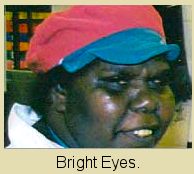 While he found and treated problems caused by medical neglect in these people Fred Hollows also observed that they possessed much sharper vision than non-indigenous Australians. The outback pioneer and author, Dame Mary Gilmore, recorded that Aboriginal people can see fainter stars than other Australians and she also noted that Aboriginal stockmen could count cattle in groups of four or five; a skill they had learnt from counting stars in the heavens. Is it possible that people with better eyesight than ours, and who have been taught special knowledge from generation to generation, are capable of discerning colours in lizard intestines that we simply cannot see or interpret? While he found and treated problems caused by medical neglect in these people Fred Hollows also observed that they possessed much sharper vision than non-indigenous Australians. The outback pioneer and author, Dame Mary Gilmore, recorded that Aboriginal people can see fainter stars than other Australians and she also noted that Aboriginal stockmen could count cattle in groups of four or five; a skill they had learnt from counting stars in the heavens. Is it possible that people with better eyesight than ours, and who have been taught special knowledge from generation to generation, are capable of discerning colours in lizard intestines that we simply cannot see or interpret?
In their research for their book, Civilization One, Knight and Butler found what they believe to be a connection between sound and colour. Modern science does not recognise any such connection, but Knight and Butler found that when the Megalithic tuning scale is raised by exactly 40 octaves it fits the visible light spectrum like a glove. Here is what they say about it. - "Then we discovered, more or less by accident, that the frequency of the basis Megalithic note of 366 Th (560 Hz) has an unusual property. If we double this frequency exactly 40 times, we arrive at 6.15726511 x 10 14 Hz, which just happens to bring us to the visible spectrum and that part of it that we see as the colour blue. Even though, from the standpoint of physics, there is no apparent connection between a sound of 560 Hz and an electromagnetic frequency of 6.15726511 x 10 14 Hz, there has to be a 'sympathetic resonance' between the two. This fact may, in some so far unknown way, be understood by the Aborigine playing his didgeridoo under the bright blue skies of Australia."
If there is a connection between sound and colour, and a knowledgeable and skilled person could translate between the two, it raises the possibility of detecting the vibrational signature of precious metals in minute concentrations of the gut of a lizard that drinks the ground water leached from underlying deposits. This is, of course, hypothetical at this time; but it is not in the category of a fairytale. It is not Pooh Corner. When indigenous people like Joan Wingfield tell us their dreaming stories and how they apply them, they are telling us their cultural knowledge - and it could be up to 60,000 years old. They are also doing so in all seriousness; they are not 'pulling our leg'. We should listen to them a lot more, for we could be hearing the last available verbal records of an ancient super-science.
Recall that Hans Jenny's research led him to the conclusion that tone and sound represent the fundamental creative power. Albert Einstein also realised this, as did Nicola Tesla and many others, but their practical discoveries never made it past "Top Secret". Humanity was denied the fruits of such knowledge throughout the 20th century Scientific Dark Age; for purely military reasons. It would be ironic indeed, if the British Redcoats who set about subduing indigenous tribes from the time of their invasion of Australia in 1788, were using muskets and cavalry against peace-loving Stone Age people who, nevertheless, possessed the secrets of a super-science that could, even today, enable the defeat of the world's only remaining superpower - the U.S.A. - is a single battle.
A Forgotten Civilization In Australia
The stone arrangements on Roxby Downs are gone, and it might seem that we will never know their purpose or who might have built them. But we need not worry about any lack of megaliths to study, the Australian landscape is peppered with them. Many are very old and weathered by time, but they exist in plentiful numbers.
Rex Gilroy, who lives in the Blue Mountains of New South Wales, has done considerable exploration and research into what he terms "A Lost Megalithic Civilization". 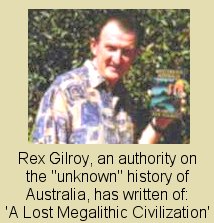 He points not only to Australian reports, stories and physical structures, but also to the legends of the Maori people of New Zealand that speak of "Uru" of the "Great West Land" that was, "inhabited by a race of people who built in stone and were expert astronomers". Since the aboriginal nations of Australia were nomadic people who lived off the land as they found it, it seems unlikely that they were the race referred to by the Maoris. The megaliths and stone circles that Rex Gilroy has studied would have required considerable resources and engineering skills to construct. It seems that the people who built them would not have been wandering around the country, hunting and gathering food. Rather than a nomadic hunter-gatherer culture we are probably looking at a true civilization, and one with some very advanced knowledge. Rex Gilroy's web site is
www.mysteriousaustralia.com/uruan_links.html
and he has written several books about his work.
Here are some excerpts from Rex Gilroy's articles on the evidence of a lost Megalithic Civilization in Australia. - Blue Mountains and other parts of N.S.W.
"I stumbled upon a lengthy alignment of large sandstone rocks forming a north-south axis for about 100 yards of so through dense scrub. Developers eventually claimed the site, but in 1969, while crossing a hillside near Fish River just west of the Blue Mountains and south of Lithgow, I came upon a large granite upright-standing, pillar-like rock which gave every appearance of having been erected by human hands. The rock is about 15 feet tall and a few feet in circumference. What appeared to be symbols carved on the stone were so badly weathered as to be indistinct. In September of that year I learned of a series of mysterious granite structures down in the Snowy Mountains district of Southern NSW and, later, of another similar formation in the Armidale region of New England." - Bathurst, N.S.W.
"... one very wet and miserably cold day in August 1974, we found ourselves in a grass covered field in pouring rain, standing before a row of crudely shaped granite rocks that seemed to stretch into the distance across neighbouring properties. We has just found the first of a number of Western New South Wales megalithic stone arrangement sites which, over the years, we still regard as our greatest archaeological discovery. ... The stones averaging 120 pounds in weight (although some were heavier) extended in a line from south to north, one behind the other, measuring from a few feet apart to as much as a couple of yards, for up to a mile. I soon found from measurements of the distance between each stone that these measurements repeated themselves at intervals throughout the entire alignment. It was obvious to us that there was a mathematical purpose here. ... Then, near the southern end of the first alignment, I came upon a structure which gave me an even greater surprise. Erected upon a granite base about 4 feet wide was a circular formation of of 10 large, weathered granite boulders forming a miniature "Stonehenge". One of these stones had been shaped to form an altar. Nearby, leading from the circular structure, I noticed three other stones separated a few feet apart and erected one behind the other in a north-westerly direction. ... Continuing in the north-westerly direction I soon found myself looking at three huge balancing rocks, each placed upon its own platform. A natural enough sight, I thought at first, that is, until I measured the distance between each to find they formed a perfect triangle, each stone between 60 yards by 60 yards apart. ... I was to discover, a few hundred yards further on again, a large granite rock, 15 feet tall with a 33-foot circumference, a menhir erected upright upon a base of carved granite blocks partly covered by soil. 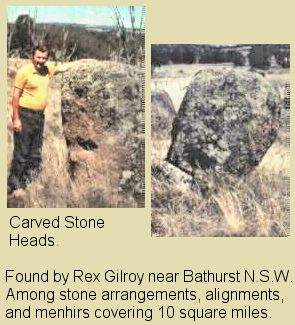 Excavating the soil from the southern end of the platform, we discovered it to be composed of three large blocks. The largest of these measured 8 feet long by 4 feet wide by 3 feet thick; the other two were each 4 feet by 4 feet. Nearby, over a hill I found four smaller granite stones forming a perfect square. But it was in the vicinity of the north-west alignment of stone structures that I was to find what I consider to be the most remarkable structures of the entire series of megalithic marvels hereabouts. Excavating the soil from the southern end of the platform, we discovered it to be composed of three large blocks. The largest of these measured 8 feet long by 4 feet wide by 3 feet thick; the other two were each 4 feet by 4 feet. Nearby, over a hill I found four smaller granite stones forming a perfect square. But it was in the vicinity of the north-west alignment of stone structures that I was to find what I consider to be the most remarkable structures of the entire series of megalithic marvels hereabouts. There before me stood, like sentinels guarding the works of this vanished race: three carved human heads ! The largest, a 20 foot tall by 15 foot circumference head and torso figure, was badly weathered with indistinct facial features; the other two each measured 6 feet 10 inches tall by 6 feet in circumference. ... But, we asked ourselves, who built these megalithic formations of standing stones, stone circles, dolmens, numerous alignments of varying length, etc., covering an area of approximately 10 square miles. the entire site was nothing less than one great open-air observatory. Some of these structures included massive blocks of granite, one about two storeys in height and almost that in width, beneath which passed a lengthy alignment. One day while exploring the countryside at a point between the two one-mile long alignments mentioned earlier,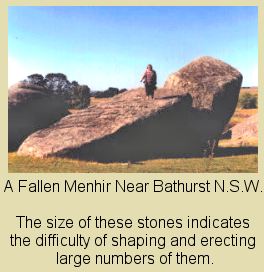 I came across two massive menhirs, a couple of hundred feet apart on and east-west axis. I measured them at 21 feet and 19 feet in height respectively, and estimated they weighed at least 8 and 10 tons each. The eastern menhir had a small altar stone at its eastern base. I came across two massive menhirs, a couple of hundred feet apart on and east-west axis. I measured them at 21 feet and 19 feet in height respectively, and estimated they weighed at least 8 and 10 tons each. The eastern menhir had a small altar stone at its eastern base. These and many more often massive stones making up various formations, presented us with the problem of how such monolithic stones could have been dragged into place and erected even with the primitive means that scholars suggest were available to man in those times. But we can be certain that, whoever the builders were, they worked with advanced building techniques. A good example of their abilities exists nearby the western edge of the two one-mile stone alignments. Upon a hillside we found a 'water hole', 1 foot wide by 2 feet by 3 feet deep, which had been cut out of a solid granite rockface. But how? the granite in this area blunts any modern engineer's drill ! Surely, no known stone arefact could have done the job - and we certainly have yet to learn how these ancient stonemasons carved the other artworks hereabouts." Other sites in Australia. "It is now 19 years since our investigation of the 'Bathurst Stonehenge' began, and our work hereabouts continues. We have heard of a number of other apparent astronomical stone arrangement sites in central Queensland, the Northern Territory, Western and South Australia, Victoria and Tasmania. It is obvious the 'lost civilization of Australia' was nationwide in extent ... Residents of the Dapto district south of Wollongong on the NSW south coast recall the Dapto 'Stonehenge' that stood by the town until the early 70s. Consisting of 12 huge boulders arranged in a circle, it was destroyed by a construction team for a local government development. Had it served as yet another ancient astronomical site? At Gosford on the NSW central coast, stand large stones set amid circular, raised earthen mounds. These central stones have been hollowed out saucer fashion. Water poured into the hollows was the means by which ancient astronomers were able to see a reflection of the heavenly movements by night. Also at Gosford, atop a mountain is a flat area now covered with trees hundreds of years old but which, thousands of years ago, would have been cleared. For here stand sandstone blocks, the remains of some enormous edifice. In the same area, upon a flat shoal of rock are 50 circular symbols, some joined by lines, others in formation, perhaps representing the movements of certain stars or planets."
The 'Stone Of The South' Puzzle
Rex Gilroy and his wife Heather are not the only people who are puzzled by the size of stones at megalithic sites and how they were moved and positioned by ancient builders. The menhirs at Gosford, of 8 and 10 tons, are lightweight by comparison to those at Baalbek in Lebanon. There, precisely squared stones of 800 tons have been used in the construction of the pre-Roman foundations of the, now ruined, Temple of Jupiter. Writing of this megalithic stonework, Alan F. Alford, in his book, Gods of the New Millennium, observes that he measured the blocks of the sixth course as averaging 64 feet in length and having a height of 14 feet 6 inches and a thickness of 12 feet. They are each estimated to weigh 800 tons, and they fit together so precisely that it is impossible to slip a sheet of paper between them. But, in the quarry from which they came, on a nearby hillside some ten minutes walk away, lies an even larger block known as the Stone of the South. The following image, taken by Alan Alford, shows the scale of this gigantic block. Note the two people on it, one standing and the other sitting. This stone is thought to weigh around 1,000 tons.

Here is what Alan Alford wrote about the puzzle of how stones of 800 and 1,000 tons could have been moved and placed on top of each other. - "The Arabs believed that Baalbek belonged to the legendary Nimrod, who once ruled this area of Lebanon. According to an Arabic manuscript found at Baalbek, Nimrod sent giants to rebuild Baalbek after the Flood, whilst another tale relates that Nimrod rebelled against his god and built the Tower of Babel at Baalbek. ...
The local Muslims also believed that it was beyond the capabilities of humans to move the enormous stones of Baalbek. Instead of giants, however, they credited the work to demons of djinn. The English traveller, David Urquhart, in a similar vein, suggested that the builders used mastadons - huge extinct elephant-like mammals - as mobile cranes to help them move the stones. It is sometimes claimed that modern cranes cannot lift stones as heavy as Baalbek's 800-ton monoliths. This is actually incorrect. I posed the problem of the Baalbek stones to Baldwins Industrial Services, one of the leading British crane hire companies. I asked them how they might attempt to move the 1,000-ton Stone of the South and place it at the same height as the Trilithon. Bob MacGrain, the Technical Director of Baldwins, confirmed that there were several mobile cranes currently available that could lift and place the 1,000-ton stone on a support structure 20 feet high. Baldwins themselves operate a 1,200-ton capacity Gottwals AK912 strut jib crane, whilst other companies operate cranes capable of lifting 2,000 tons. Unfortunately, these cranes do not have the capability to move whilst carrying such heavy loads. How then might we transport the Stone of the South to the acropolis? Baldwins suggested two possibilities. the first would use a 1,000-ton capacity crane fitted with crawler tracks. The disadvantage of this method would be the need for massive ground preparation works in order to provide a solid, level roadway for the crane to move. The alternative to a crane would be a series of modular hydraulic trailers, combined to create a massive load carrying platform. These trailers raise and lower their loads using hydraulic cylinders built into their suspension. The initial lift at the quarry would be achieved by the use of a cut-out section beneath the stone, which the trailer would drive into. The final positioning in the wall, at a height of 20 feet, would be achieved by using an earth ramp. There is, of course, one slight problem with Baldwin's solution. None of this twentieth century technology was supposedly available when Baalbek was built. What happens if we fall back on non-technological methods? The usual suggestion is that megalithic stones were moved using a system of wooden rollers. However, modern experiments have shown such rollers being crushed by much lighter weights than 800 tons. Even if such a system was possible, it has been estimated that it would take the combined efforts of 40,000 men to move the Stone of the South. It remains completely unproven that an 800-ton stone could have been moved using such primitive methods."
Clues To The Solution Of The Puzzle
There are two groups of people who already know, or at least have the information to find out, how huge objects such as the Stone of the South were lifted, transported and positioned. One group works with suppressed knowledge within the research laboratories and 'black projects' of central governments. Their focus is on finding 'better' and more efficient ways of exterminating ordinary folk like you and I - with weapons of mass destruction. Needless to say this group consists entirely of Takers. A second broad grouping covers two subclasses of people. The first subclass consists of independent, non-government funded, researchers and thinkers who explore knowledge trails to suppressed technologies and an ancient super-science. The efforts of these people are being greatly assisted by the rise of the Internet as a source of rare information and as a forum for the exchange of ideas that undermine the 'official truth'. Members of this group tend to be Takers (because they were so raised and educated) or latter-day Leavers (who have seen the folly of our present society, and converted from takerism).
This edition of this freesite is not the place to set out the solution to the puzzle of how the ancients moved great stones and erected their megaliths and stellar observatories. However, many of the clues are contained in the 2nd Renaissance freesite. If you can't wait for a future edition to join all the dots together and reveal the solution to the puzzle have a look at the following sub-headings there: [34] [36] [208] [215] [216] [218] [220] [221] [222] [223] [228] and [241]. As Scully and Mulder well know: 'The Truth is Out There'.
In this edition we are most interested with the second subclass of the group of people who already know, or possess the information to find out, how very large stones were so effortlessly moved and placed into position. These people are original Leavers. They are the surviving indigenous Australians who, through their carefully preserved stories of the Dreamtime, are living records of pre-historic contact with an advanced race of astronomers and stonemasons that now seems to have vanished from the Earth.
Knowledge Preserved
Because we are used to preserving knowledge in a written or printed form, on paper or on electronic media, we are initially sceptical of the accuracy of verbal ways of preserving information. We don't do it, so we tend not to understand it. But consider the following snippets from common nursery rhymes, and see how easily you can fill in the blanks. - Mary had a little ____ its ______ was _____ as ____ and everywhere that ...
- Humpty Dumpty sat on a ____ , Humpty Dumpty had a great ____ . ...
- Little Bo - ____ has lost her _____ and doesn't know where to find them ...
- Diddle diddle dumpling, my son ____ , went to bed with his ________ on.
If you grew up in an English or American culture and learnt these rhymes as a young child you probably got them all - ten out of ten right. Your mother and father would also have got them all, so would their mothers and fathers, and so on. In fact, the accuracy of the rhyme would be preserved through the generations; from the time it was first introduced into the culture. Amazing, hey. No need for written down or printed words at all. You might, like many children, have also used the rhymes to learn to read, but you would have heard, repeated and memorised the words first. Of course, you say, not everybody in our present culture knows these rhymes. But what if, as happens in indigenous Australian culture, religion and the law were inseparable and it was a requirement for every child to learn these rhymes or stories? Yes, that's right, we would all know them all - word perfect !
If we were living as nomadic hunter-gatherer tribes, rote memorisation of the collective knowledge and wisdom of the culture would be the most practical way of preserving and transporting it. Aboriginal Australians did not wheel their knowledge around in 4-drawer filing cabinets. They carried all their knowledge in their heads and they passed the stories that contained the knowledge from generation to generation; at a young age. We might think that this would have been hard to do, but to them it was easy.
As has already been observed, the indigenous Australians were not memorising nursery rhymes or fairytales; they did not strive to remember The Complete Works of Winnie The Pooh, by A. A. Milne. Instead they preserved practical knowledge of how to survive in the Australian landscape; how to nurture and maintain the environment that sustained them, how to relate to each other and the divine order of things, and much more. They did not waste their time remembering anything other than knowledge that really, really needed to be preserved.
Long Memories - An Aboriginal Zodiac
Scholars, researchers, theologians, and others disagree about the dates of major events in pre-history; but usually by thousands of years rather than tens of thousands. When compared with estimates of constructions and events in other parts of the world the indigenous Australian culture can be seen to have been very successful in handing-down knowledge over remarkably long periods.
Take the example of the Aboriginal Zodiac. In 1998 the Australian media reported the discovery of an Aboriginal zodiac by Swinburne University of Technology lecturer and cultural researcher, John Morieson. The following excerpts summarise the story. - "When Lake Tyrell Aborigines looked into the night sky in Dream tine Australia they saw not the Southern Cross, but a ring-tailed possum sitting atop a blazing bough of light. New research has revealed that the ancients devised their own zodiac, charting the pattern of the seasons and life in pre-European Australia through a unique view of the heavens.
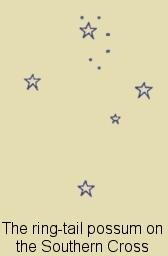 In their sky, a giant emu reposes between the southern Cross and Scorpius, the Gemini twins are formed by a tortoise and fantail cuckoo and a pair of brolgas make up the milky clouds of Magellan. ... In their sky, a giant emu reposes between the southern Cross and Scorpius, the Gemini twins are formed by a tortoise and fantail cuckoo and a pair of brolgas make up the milky clouds of Magellan. ...... John Morieson believes this zodiac easily predates its European counterpart - probably developed by the Assyrians or earlier by the Babylonians in about 2000 BC - given two pieces of evidence. These are the presence of a giant emu in the indigenous zodiac, and carbon-dating which places human occupation at Lake Tyrell in Victoria's north-west - the home of the Boorong - at a minimum of 23,000 years. In a development that could lead to a reappraisal of how Aboriginal people pass on lore across the generations, Mr Morieson matched the knowledge with stars in the Australian night sky for 40 different native birds, animals and people. The creatures include the fan-tailed cuckoo in Castor, the long-necked tortoise in Pollux, the red kangaroo in Capella and the mallee fowl in Lyra. Crows, eagles, parrots, lorikeets, dancing men and song men are included in this indigenous pantheon." The Weekend Australian, October, 24-25, 1998. - "Archaeoastronomy is the study of astronomical practices and lore of ancient cultures. Stonehenge, the alignment of the Great Pyramid at Giza in Egypt, and the Maya Palace in Yucatan make it clear that ancient cultures understood something of astronomical principles, and had their own celestial calendars - but that's not to say Australia doesn't have its own contributions to make in the field.
The term 'zodiac' in this case has nothing to do with astrology. While the Boorong people identified different animals in the sky - seeing a fan-tailed cuckoo in what we know as Castor and a mallee fowl in Lyra, for example - they did not assign personality characteristics or attempt to make predictions, as we've been known to do with astrology. Instead, they tied the zodiac with knowledge using shapes in the sky to pass on information about food-gathering seasons and climate. ... John recently attended the Oxford 7 archaeoastronomy conference in Flagstaff Arizona - the only Australian to do so. ... he introduced the conference attendees to the Boorong zodiac. The difference between it and Stonehenge or the Maya pyramids is time - the Mayans disappeared centuries ago, taking their secrets with them, while the Boorong were still around under two centuries back and shared their knowledge with white locals." Australian Broadcasting Commission (ABC) Radio. Seeing stars - in an entirely different way. 19 August, 2004. - "Aborigines had a zodiac thousands of years before the first European equivalent, according to a Melbourne academic.
John Morieson, of Swinbourne University in Melbourne, says that they had a highly sophisticated understanding of the seasons and the world around them 23,000 years ago. ... ... "A study of these sky creatures reveals encyclopedic oral knowledge, a thorough understanding of the seasons and no need for a written culture," Mr Morieson says. He adds that there is evidence for the zodiac from Aboriginal folklore passed on in the 1840s by the now-lost Boorong people. ... Mr Morieson worked for four years with local Aborigines on data first gathered by a Victorian grazier, William Stanbridge, and presented to the Philosophical Institute of Melbourne in 1857. His material was based on first-hand accounts from Boorong elders who identified 30 stars and constellations used by tribal Aborigines. He recorded each Aboriginal term and its equivalent in the European zodiac. The work, which is expected to make a significant impact on Aboriginal studies, has been accepted for publication by Melbourne University Press." The Times (London) 14 November, 1998.
The rediscovery of the lost Boorong zodiac gives us an indication of just how long-lived Aboriginal knowledge could be. Consider this: the megalithic foundations at Baalbek are associated with the legendary Nimrod and, on this basis, dated by Alan Alford at c. 3450 BC. But, from the carbon-dating of the Boorong settlement at Lake Tyrell, the Aboriginal zodiac dates from around c. 21000 BC. It's probably seventeen thousand years earlier than the construction at Baalbek !
According to the 'official truth' the Great Pyramid at Giza was built in about 2500 BC. Various researchers and scholars, of which Alan Alford is one, consider it to be much older. He dates it at 10450 BC. But the Aboriginal zodiac is far older than even that date. It's almost twice as old as the earliest estimate of the Great Pyramid's construction !
Of course, John Morieson's carbon-dating might be wrong and the Aboriginal zodiac might not be as old as these comparisons suggest. However, other evidence supports the great age of the indigenous zodiac in Australia. Firstly there is the fact that Aboriginal people are known to have continuously inhabited the continent for some 60,000 years, so it is possible that they were using a zodiac in 21000 BC. Secondly there is the obvious age of the astronomical observatory discovered by Rex Gilmore near Bathurst, in New South Wales. The blocks of carved and inscribed granite are still standing where someone placed them a long time ago. There has only been wind and rain at work on these very hard stones which, as Rex Gilroy notes, will quickly blunt modern engineer's drills, yet the weathering is extreme. Most of the inscriptions are almost impossible to read, and the carvings of human heads and torsos are also much affected by age. These objects were placed, carved and inscribed a very long time ago.
Yet, although the information on the stones is almost oblierated the oral traditions of the Aboriginal nations in the area will have preserved, intact, knowledge that stretches back before the earliest known constructions in Europe and the Middle East. That's pretty amazing when you think about it.
Lessons From A Culture
It seems very probable that, if indigenous stone arrangements and sacred sites can be protected from mining and land development long enough for open-minded archaeologists, anthropologists and archaeoastronomers, aided by living Aboriginal elders, to decipher the stones and the sreaming stories, much valuable knowledge might be uncovered.
There were clearly very advanced people in Australia in pre-historic times and there could be much that can still be learned from the descendants of people who knew and were taught by them. For example, it is probably not a coincidence that an Aboriginal 'Stonehenge' and the British atomic tests were both located in the same vicinity in South Australia. Modern scientists working on WMDs, and an ancient and mysterious race that choose that particular spot as a sacred site thousands of years ago, both seem to have been aware of the Earth Energy Grid (see sub-heading [222] of the 2nd Renaissance freesite for details) and used its properties in their work. At any rate, coincidentally or not, they both picked a significant nodal area of the grid for their work.
Besides the possibilities of discovering knowledge and links to an ancient super-science that could have been practised in Australia tens of thousands of years ago, there are vital social lessons to be taken from an expanded knowledge of the Leaver philosophy and culture of the first Australians. It is no accident that the relatively 'recent' ruins at Baalbek have lost all their history, while the secrets of the many observatories and ceremonial sites of pre-historic Australia might still exist in the memories and stories of living indigenous people.
Baalbek is situated at the western edge of what is thought, rightly or wrongly, to have been the 'cradle of civilization'. The fertile crescent between the Tigris and Euphrates rivers, in what was then Mesopotamia, became the early centre of agriculture and a town-based society instead of a nomadic hunter-gatherer existence. With the storage of food came standing armies and the whole Taker mindset which has been responsible for untold death and destruction on this planet, and which is still the dominant economic and political model.
There is no history of Baalbek because takerism, and the many wars it generated, completely obliterated it. Records were destroyed, people with memories of the history were killed, and the whole lot was lost to future generations. All we can do now is look at wondrous objects such as the Stone of the South and scratch our heads. Takers destroy their own history and, eventually, their own society and culture. That lesson is clear and it can be found all over the western world.
Despite the fact that the Aboriginal zodiac is far older than the ruins at Baalbek, and not even a tangible object, knowledge of it has persisted to the present day. It was a close thing, but the Boorong elders explained their zodiac to William Stanbridge and he documented it so that the information survived their extinction by European 'civilization'. The Boorong, and all the other Aboriginal tribes, were Leavers, and that is the main reason that knowledge could be kept alive for so long.
The vital lesson is that Leaver cultures tend to survive, whereas Taker cultures always experience wave upon wave of warfare and other forms of destruction. Ultimately they must fail because the concepts that underlie them are flawed.
True Civilization Involves Cooperation
Daniel Quinn is one of the early thinkers and writers of the 2nd Renaissance. In his novels, such as Ishmael and The Story Of B, Quinn describes the way successful tribal societies evolved in the times before the practices of  agricultural farming and animal husbandry made it possible to accumulate the food surpluses that led to the emergence of towns and cities, and to a new need to buy food rather than find it on the plains and in the forests of the old world. Early tribal societies evolved a way of living in conditions of managed abundance. Natural selection ensured that the societal models that were successes survived, and that the failures did not. agricultural farming and animal husbandry made it possible to accumulate the food surpluses that led to the emergence of towns and cities, and to a new need to buy food rather than find it on the plains and in the forests of the old world. Early tribal societies evolved a way of living in conditions of managed abundance. Natural selection ensured that the societal models that were successes survived, and that the failures did not. Science now understands that 19th century models of nature, that emphasised the ruthless extermination of rivals, were mistaken. A modern understanding of ecosystems and symbiotic relationships leads to the conclusion that cooperative models predominate in both the plant and animal kingdoms. However, business and government thinking remains locked into the old combative models, in which human enterprises and institutions are continually at war with each other and the planet at large. These are dead-end mindsets that cannot lead us to a higher, more advanced level of human civilization. War is not found in nature, only coexistence models succeed there.
Tribal Models Worked For Thousands Of Years
The Australian aborigines were, prior to European settlement, people who lived in conditions of managed abundance. For sixty thousand years, far longer than the fleeting histories of socialism, communism and capitalism, aboriginal tribes existed in harmony with the land. No major wars were fought. Although there were skirmishes between tribes these were seldom serious or prolonged. The aboriginal people did not experience famine because they did not exceed the population levels that could sustain a hunter-gatherer existence. They had no government except their local tribal councils, and they paid no taxes. Their religion, spirituality, and law were integrated. The emphasis of the law was on the rectification of wrongs done - there were no police and no prisons. In order to survive, the aboriginal people of Australia had only to work the equivalent of three days per week, the rest of their time was for their leisure and storytelling. The concept of suicide was unknown to these original inhabitants of the Australian continent. They also enjoyed one advantage over modern Australians; tribal people had lifelong support and cradle to grave security within their tribe. In a technological (particularly weapons) sense tribal Australians were backward, but in terms of community and social support structures they were an advanced culture.
More In Another Addition
The revision of pre-history continues apace. Many people are independently and collaboratively uncovering more and more of the truth about the existence of an advanced civilization long before records begin; at the Great Wall of History. Another edition of the Ancestors freesite will take you back even further in time than the material here. The research into the pre-history of humankind is fascinating and also very instructive; we can learn valuable lessons from an understanding of the distant past.
In closing this edition I should explain one thing about the Ancestors sub-title: 'Advanced Knowledge From Before The Flood. Several researchers, outside of the departments of archaeology in academic institutions, now consider that there were two floods in prehistoric times. They see evidence of a flood that inundated the Mediterranean area about 2500 BC, and of an earlier 'Great Flood' that covered the entire world. If you read the literature you will find dates such as 9600 BC and 10980 BC quoted for the latter catastrophe.
Thus, when Knight and Lomas, in Uriel's Machine, place the astronomical knowledge applied at Newgrange and similar British sites "before the flood" they are referring to the more recent inundation (in their case 3200 BC). When Alan Alford, in Gods of The New Millennium; and Rand Flem-Ath and Colin Wilson, in The Atlantis Blueprint, write of 'the flood' or the 'Great Flood' they are referring to the earlier, global event - 'when the sky fell'.
Science and Religion
Finally, because anything to do with the subject of creation, the timing of the flood, or the notion of the evolution of species, has the propensity to generate arguments and raise tempers; a few words about the convergence of science and religion.
It is clear from the handed-down accounts of the culture and beliefs of indigenous Australians that, to them, science and religion were indistinguishable. It is probable that many other societies from the other side of the Great Wall of History thought similarly. During the 20th century, science and religion were noticeably separated. Personally, I happen to think that this was part of a deliberate suppression of knowledge that was seen to be of great military significance by Taker minds. Be that as it may, the impact of digital technologies and the spread of information are now leading to a convergence of scientific knowledge and religious beliefs. So, it is best to keep our minds open and not take defensive positions too early or for the wrong reasons.
Let us wait and see what unfolds as modern thought and science uncover the grand design and divine nature of the universe. If you read through the 2nd Renaissance freesite you will find that there are already quite plausible theories that deny the flow of time. Einstein himself was of the view that: "... the distinction between past, present and future is only an illusion, however persistent." If the theoretical physicist and philosopher, Julian Barbour, is correct; and we live in a static universe in which we sense time in each instant, the debate about when the flood occurred might require further revision. In revealing more evidence of a devine order and design, any such change will be more likely to merge science and spirituality than drive them apart.
The thoughts I will leave you with are these: - Takers fight over everything, including differing religious beliefs, but Leavers respect everything and seek commonality and coexistence.
- No Aboriginal tribe or nation would ever intrude on or in any way damage the sacred sites of another group. They know better than that. (Pity about British Petroleum.)
- One of the major transformations of the 2nd Renaissance will involve a widespread reversion to the long-forgotten philosophies and value systems of such Leaver societies. For they, from their constant observations of the heavens, clearly understood their place in the universe and the purpose of life.
Lothar, January 2005.

|
